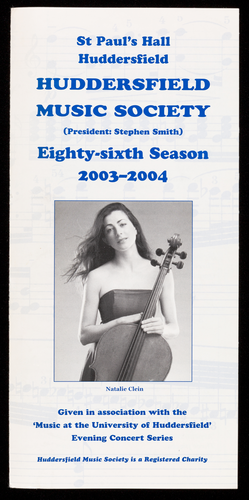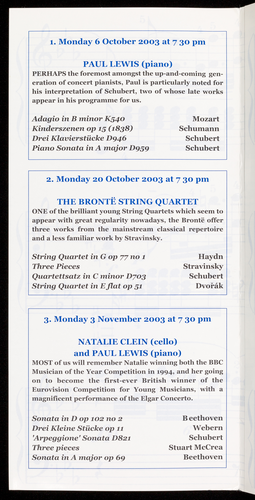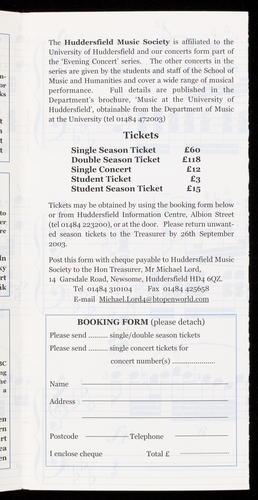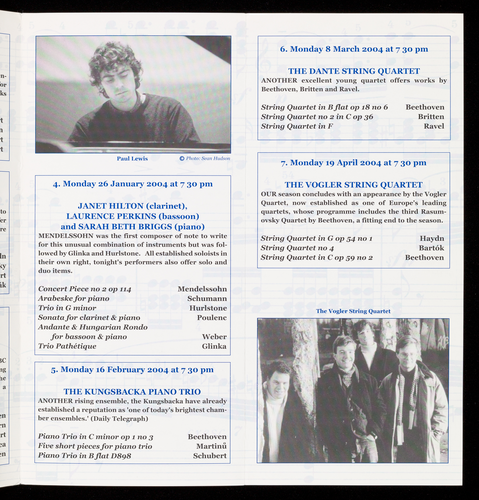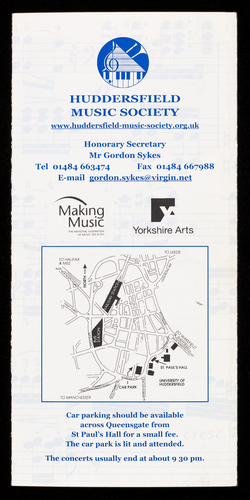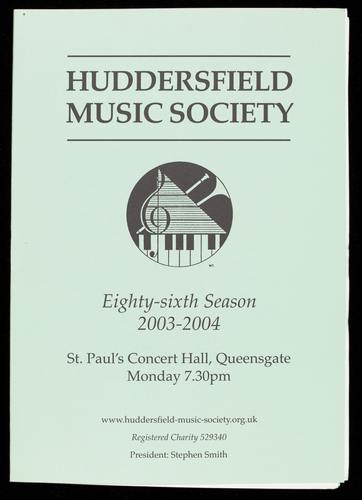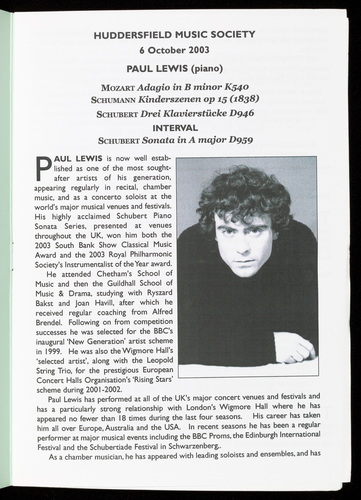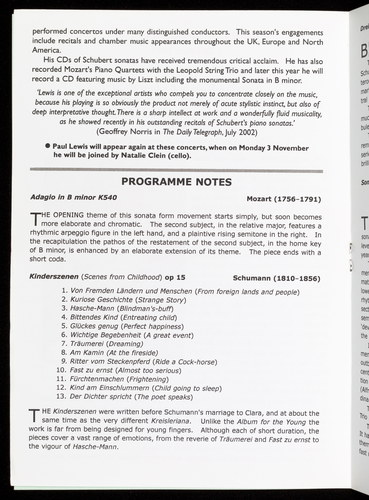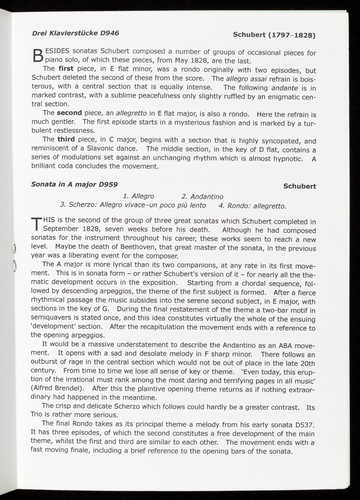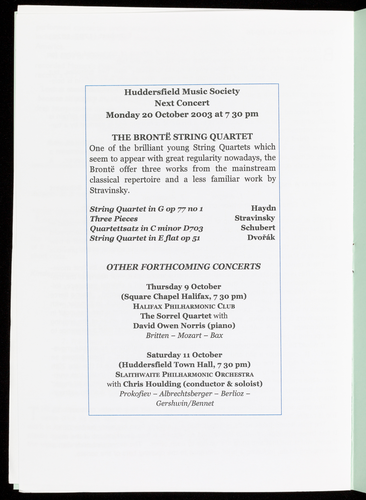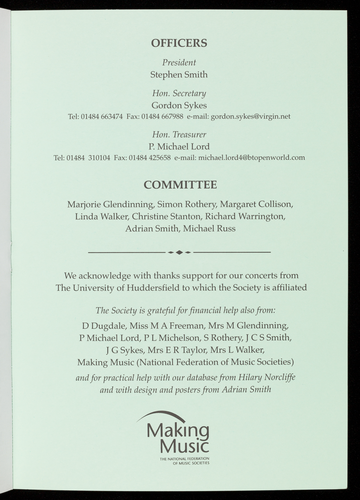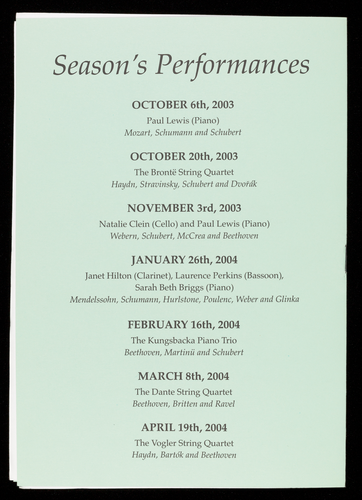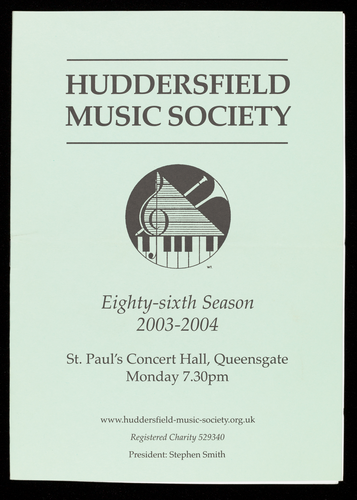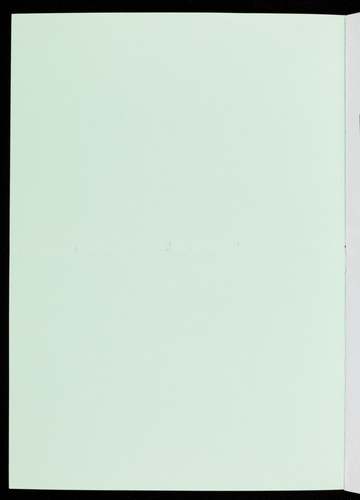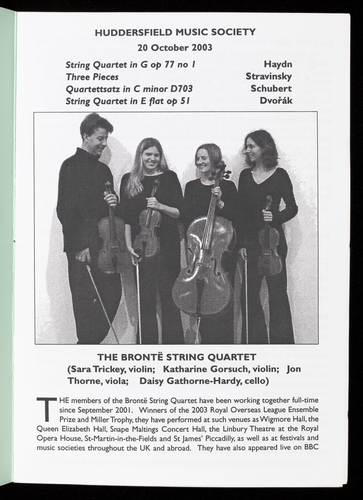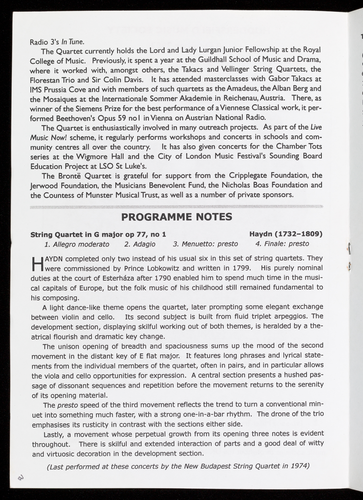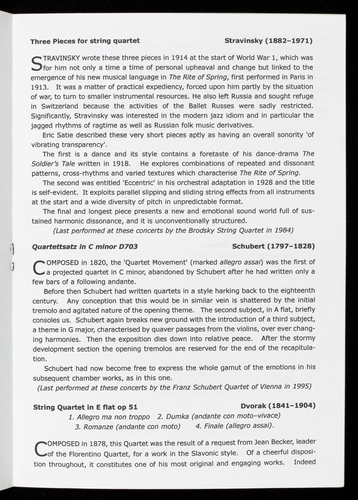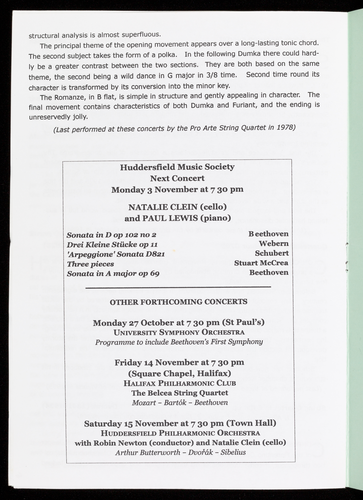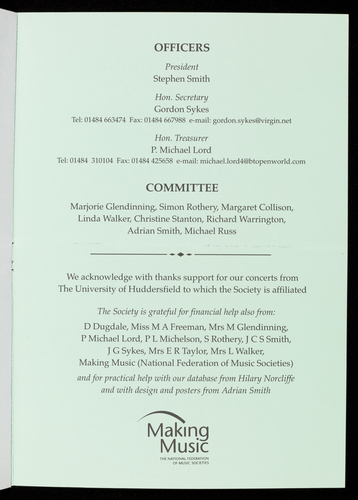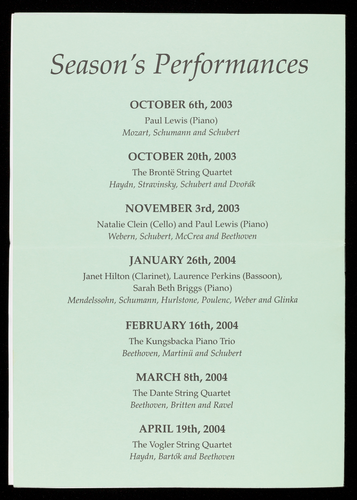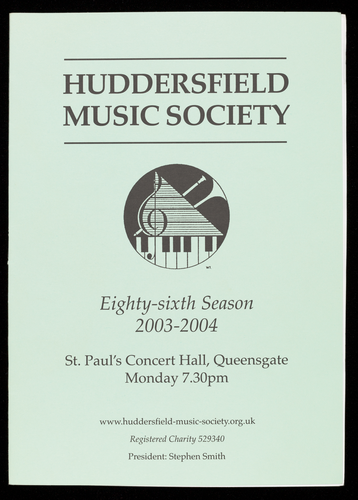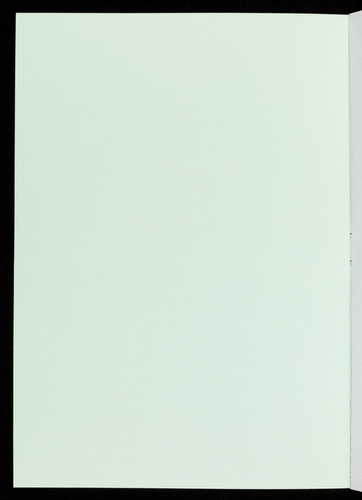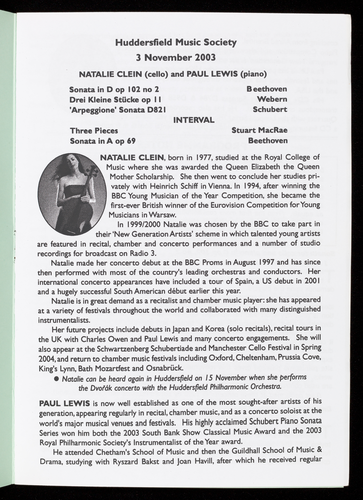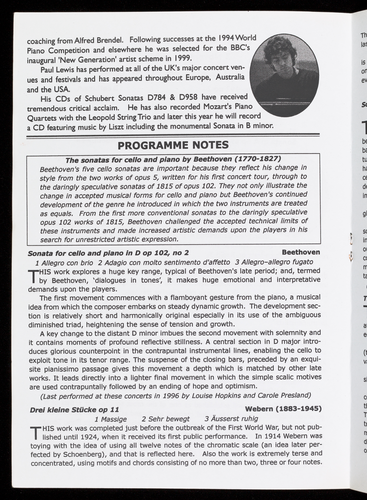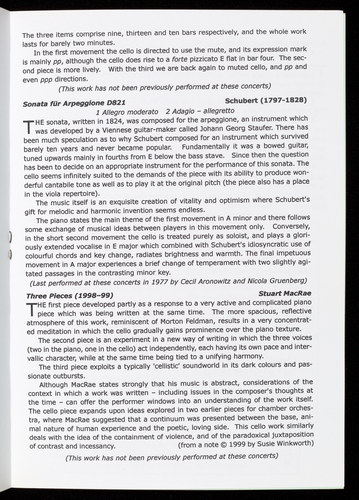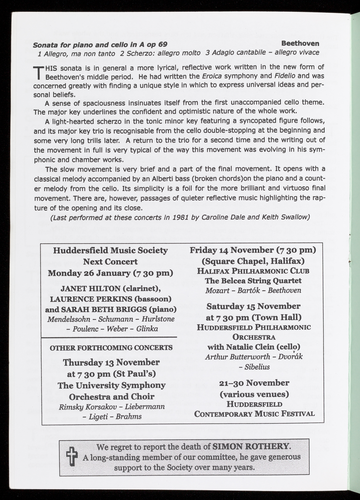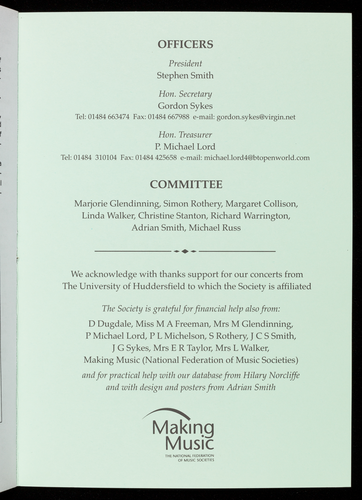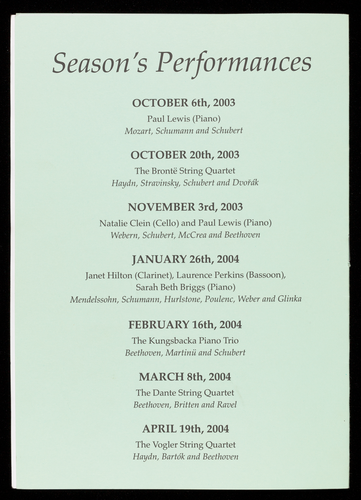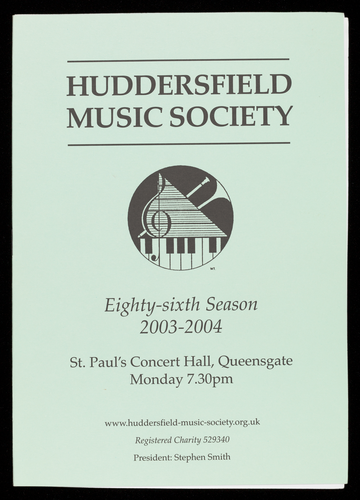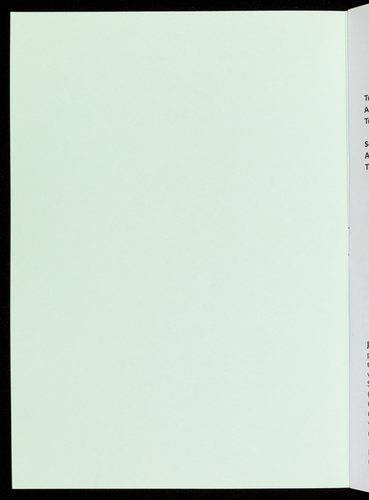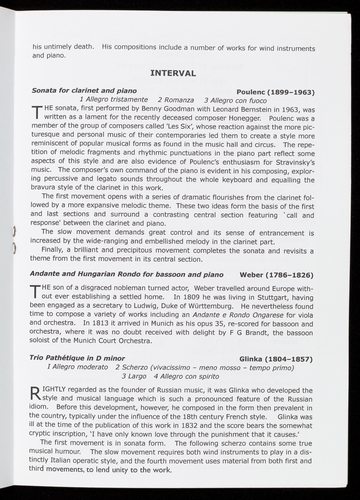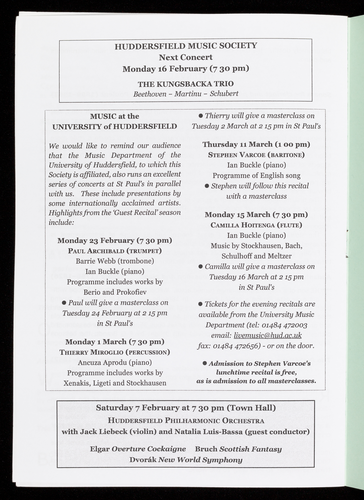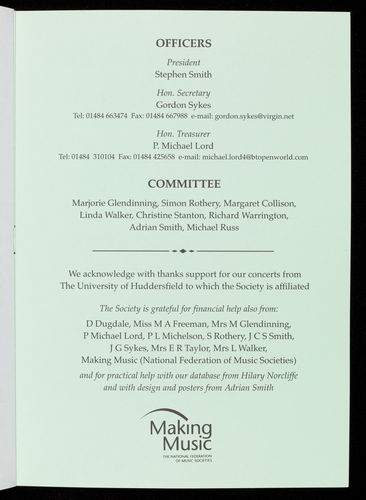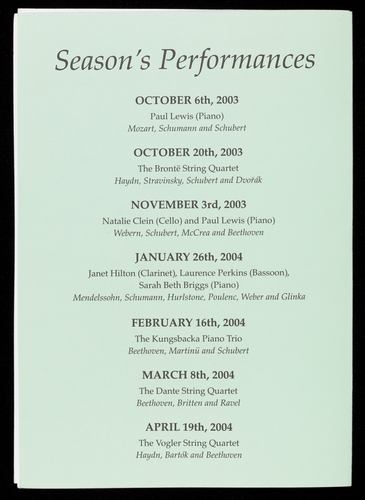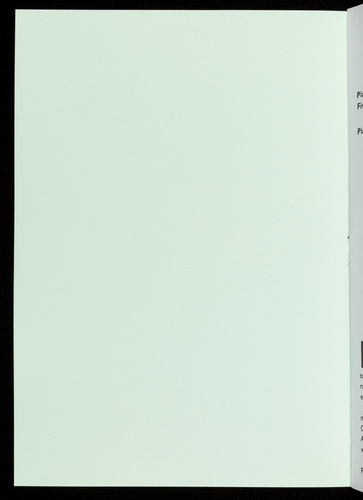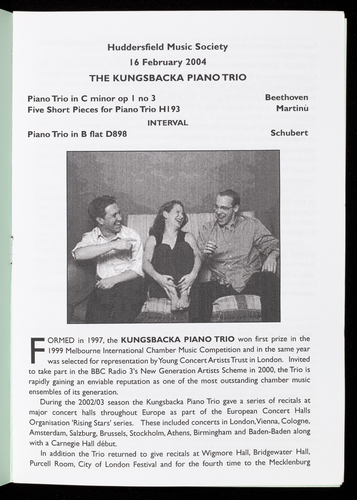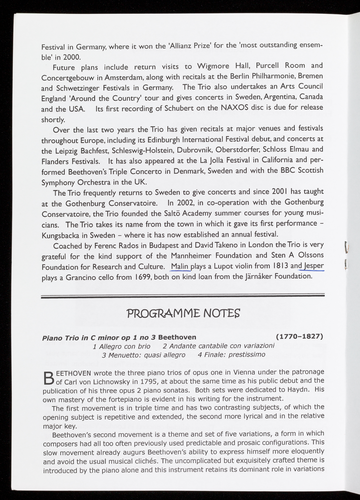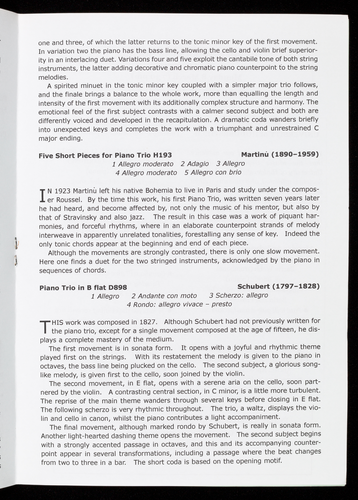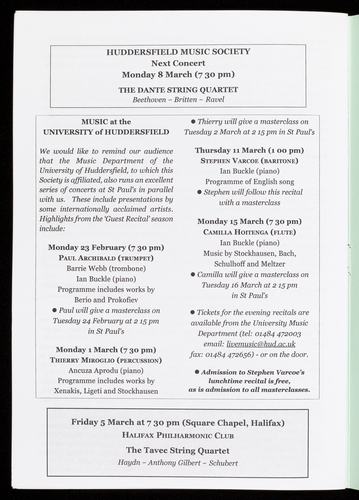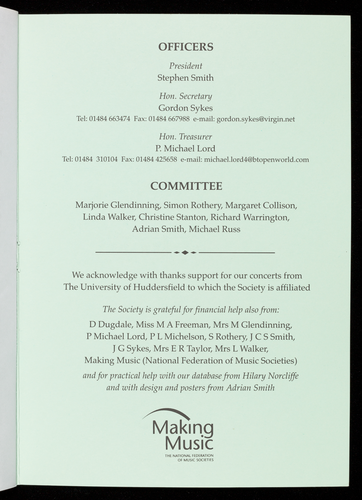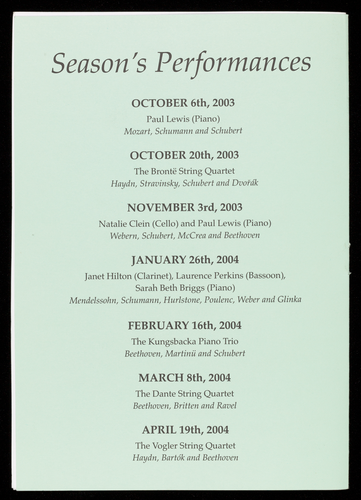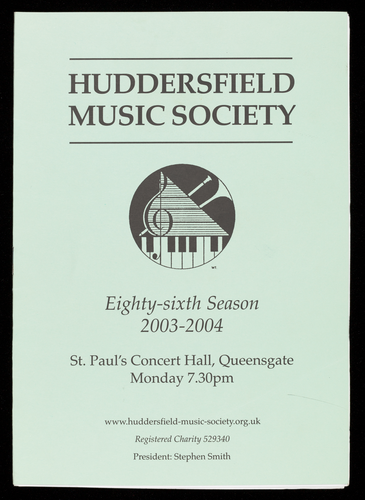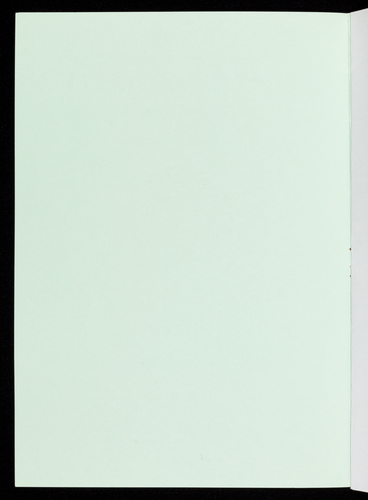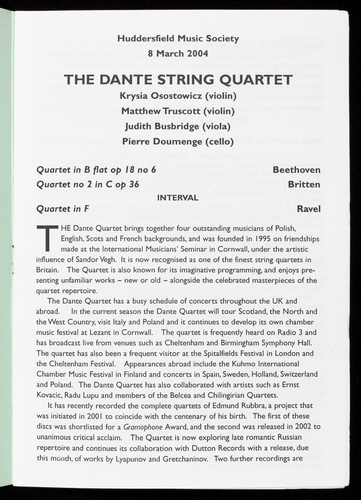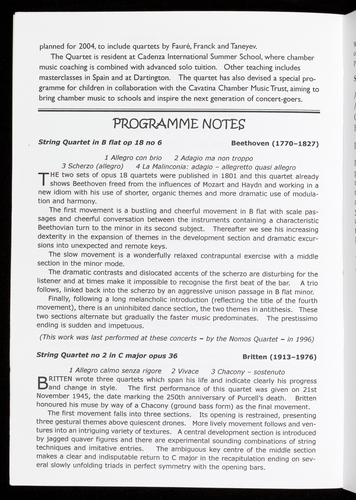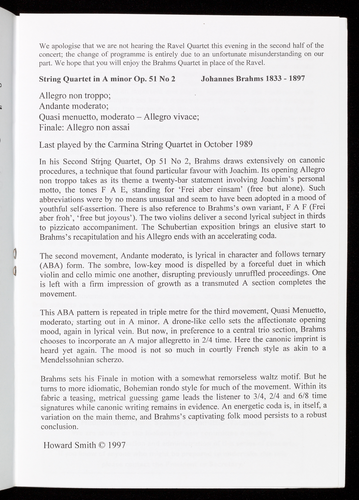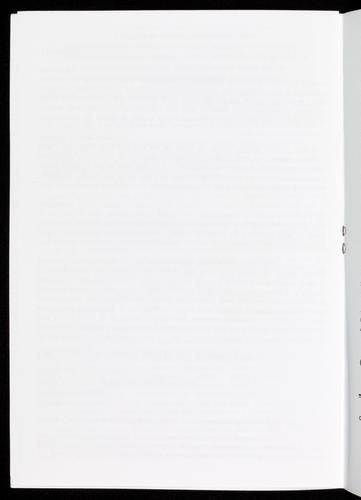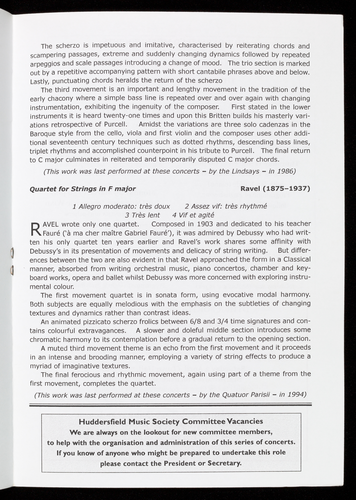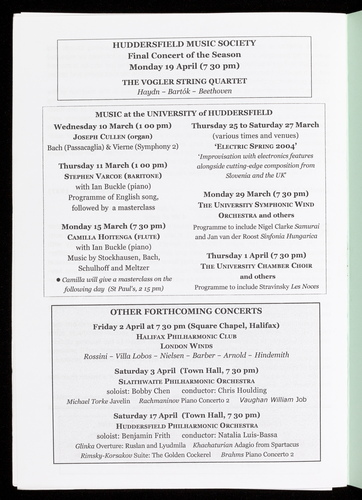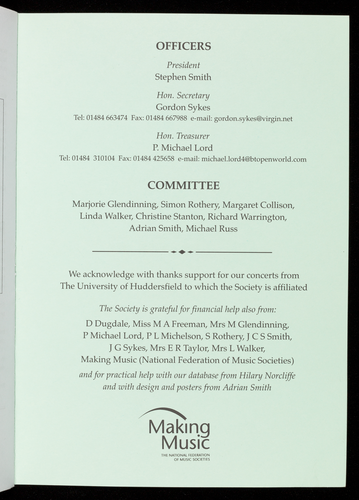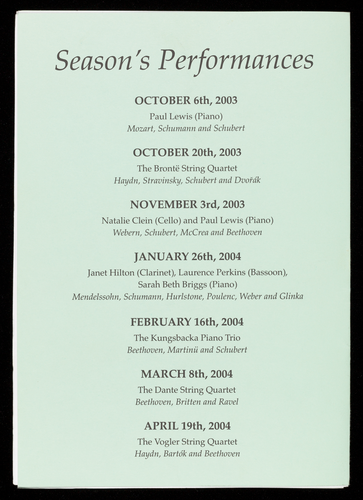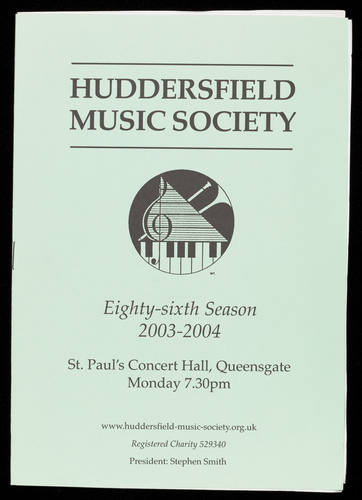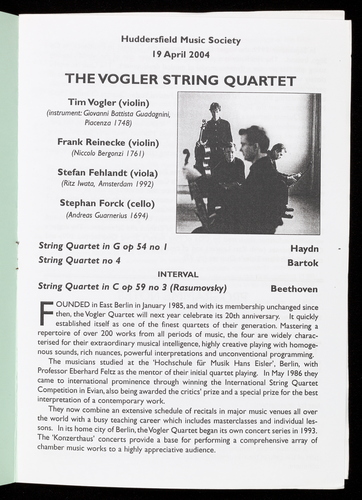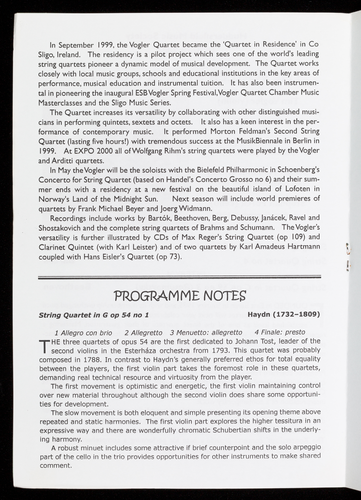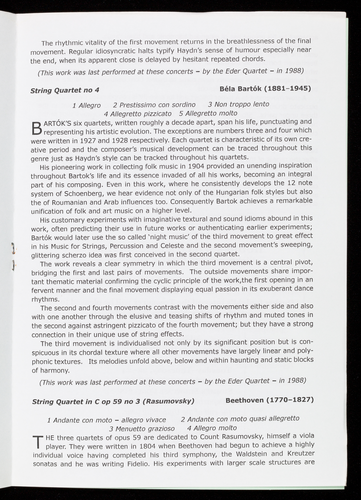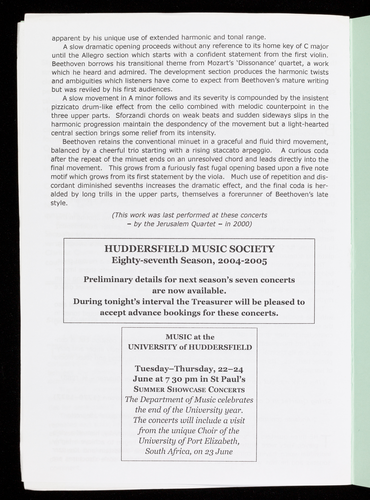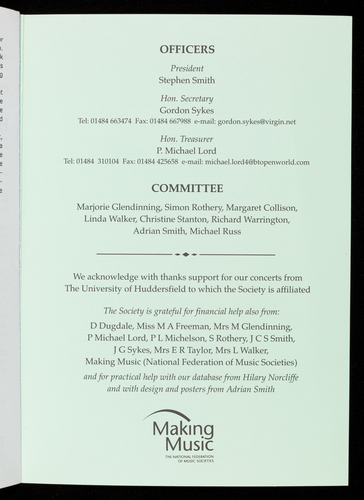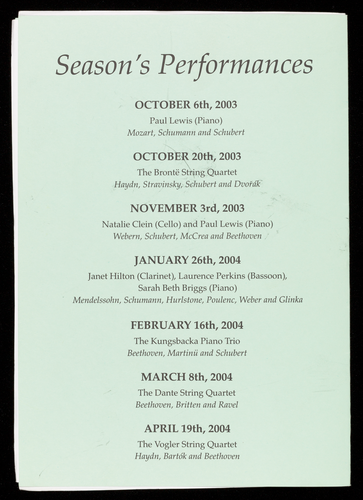Ocr'd Text:
St Paul's Hall
Huddersfield
HUDDERSFIELD
MUSIC SOCIETY
(President: Stephen Smith)
Eighty-sixth Season
2
54 2003-2004
Natalie Clein
be
Given in association with the
'Music at the University of Huddersfield'
Evening Concert Series
Huddersfield Music Society is a Registered Charity
Ocr'd Text:
1. Monday 6 October 2003 at 7 30 pm
PAUL LEWIS (piano)
PERHAPS the foremost amongst the up-and-coming gen-
eration of concert pianists, Paul is particularly noted for
his interpretation of Schubert, two of whose late works
appear in his programme for us.
Adagio in B minor K540
Kinderszenen op 15 (1838)
Drei Klavierstücke D946
Piano Sonata in A major D959
2. Monday 20 October 2003 at 7 30 pm
THE BRONTË STRING QUARTET
ONE of the brilliant young String Quartets which seem to
appear with great regularity nowadays, the Brontë offer
three works from the mainstream classical repertoire
and a less familiar work by Stravinsky.
String Quartet in G op 77 no 1
Three Pieces
Quartettsatz in C minor D703
String Quartet in E flat op 51
Mozart
Schumann
Schubert
Schubert
Haydn
Stravinsky
Schubert
Dvořák
3. Monday 3 November 2003 at 7 30 pm
Sonata in D op 102 no 2
Drei Kleine Stücke op 11
'Arpeggione' Sonata D821
Three pieces
Sonata in A major op 69
NATALIE CLEIN (cello)
and PAUL LEWIS (piano)
MOST of us will remember Natalie winning both the BBC
Musician of the Year Competition in 1994, and her going
on to become the first-ever British winner of the
Eurovision Competition for Young Musicians, with a
magnificent performance of the Elgar Concerto.
Beethoven
Webern
Schubert
Stuart McCrea
Beethoven
Ocr'd Text:
n-
or
ks
t
n
t
t
to
er
re
In
xy
rt
ak
BC
ng
he
a
en
rn
ert
ea
en
The Huddersfield Music Society is affiliated to the
University of Huddersfield and our concerts form part of
the 'Evening Concert' series. The other concerts in the
series are given by the students and staff of the School of
Music and Humanities and cover a wide range of musical
performance. Full details are published in the
Department's brochure, 'Music at the University of
Huddersfield', obtainable from the Department of Music
at the University (tel 01484 472003)
Tickets
Single Season Ticket
Double Season Ticket
Single Concert
Student Ticket
Student Season Ticket
Tickets may be obtained by using the booking form below
or from Huddersfield Information Centre, Albion Street
(tel 01484 223200), or at the door. Please return unwant-
ed season tickets to the Treasurer by 26th September
2003.
Name
Post this form with cheque payable to Huddersfield Music
Society to the Hon Treasurer, Mr Michael Lord,
14 Garsdale Road, Newsome, Huddersfield HD4 6QZ.
Fax 01484 425658
Tel 01484 310104
E-mail
Michael.Lord4@btopenworld.com
BOOKING FORM (please detach)
Please send .…......... single/double season tickets
Please send .......... single concert tickets for
concert number(s)........
Address
Postcode
£60
£118
£12
£3
£15
I enclose cheque
Telephone
Total £
Ocr'd Text:
en-
for
ks
't
n
't
t
to
er
re
in
ky
rt
ák
BC
ng
he
a
en
™n
rt
ea
en
Paul Lewis
4. Monday 26 January 2004 at 7 30 pm
JANET HILTON (clarinet),
LAURENCE PERKINS (bassoon)
and SARAH BETH BRIGGS (piano)
MENDELSSOHN was the first composer of note to write
for this unusual combination of instruments but was fol-
lowed by Glinka and Hurlstone. All established soloists in
their own right, tonight's performers also offer solo and
duo items.
Concert Piece no 2 op 114
Arabeske for piano
Trio in G minor
Sonata for clarinet & piano
Andante & Hungarian Rondo
for bassoon & piano
Trio Pathétique
O Photo: Sean Hudson
Mendelssohn
Schumann
Hurlstone
Poulenc
Piano Trio in C minor op 1 no 3
Five short pieces for piano trio
Piano Trio in B flat D898
Weber
Glinka
5. Monday 16 February 2004 at 7 30 pm
THE KUNGSBACKA PIANO TRIO
ANOTHER rising ensemble, the Kungsbacka have already
established a reputation as 'one of today's brightest cham-
ber ensembles.' (Daily Telegraph)
Beethoven
Martinů
Schubert
6. Monday 8 March 2004 at 7 30 pm
THE DANTE STRING QUARTET
ANOTHER excellent young quartet offers works by
Beethoven, Britten and Ravel.
String Quartet in B flat op 18 no 6
String Quartet no 2 in C op 36
String Quartet in F
7. Monday 19 April 2004 at 7 30 pm
Beethoven
Britten
Ravel
THE VOGLER STRING QUARTET
OUR season concludes with an appearance by the Vogler
Quartet, now established as one of Europe's leading
quartets, whose programme includes the third Rasum-
ovsky Quartet by Beethoven, a fitting end to the season.
String Quartet in G op 54 no 1
String Quartet no 4
String Quartet in C op 59 no 2
The Vogler String Quartet
Haydn
Bartók
Beethoven
KE
Ocr'd Text:
HUDDERSFIELD
www.huddersfield-music-society.org.uk
MUSIC SOCIETY
Tel 01484 663474
A629
E-mail gordon.sykes@virgin.net
Making
Music
NEW NORTH ROAD
Honorary Secretary
Mr Gordon Sykes
TO HALIFAX
& M62
THE NATIONAL FEDERATION
OF MUSIC SOCIETIES
TRINITY STREET
NORTH-
CASTLE GATE
BUS
STATION
A62 MANCHESTER ROAD
TO MANCHESTER
RAILWAY STATION
Fax 01484 667988
LOR
Yorkshire Arts
1008
00G00
A616 CHAPEL HIL
00!
0081
QUEESINGATE
CAR PARK
SOUTHGATE
TO LEEDS
QUEEN
LEEDS ROAD A62
TO WAKEFIELD
& SHEFFIELD
A629 WAKEFIELD ROAD
ST. PAUL'S HALL
UNIVERSITY OF
HUDDERSFIELD
Car
parking should be available
across Queensgate from
St Paul's Hall for a small fee. Cesc.
The car park is lit and attended.
The concerts usually end at about 9 30 pm.
Ocr'd Text:
HUDDERSFIELD
MUSIC SOCIETY
1
I
WI.
Eighty-sixth Season
2003-2004
St. Paul's Concert Hall, Queensgate
Monday 7.30pm
www.huddersfield-music-society.org.uk
Registered Charity 529340
President: Stephen Smith
Ocr'd Text:
P
HUDDERSFIELD MUSIC SOCIETY
6 October 2003
PAUL LEWIS (piano)
MOZART Adagio in B minor K540
SCHUMANN Kinderszenen op 15 (1838)
SCHUBERT Drei Klavierstücke D946
INTERVAL
SCHUBERT Sonata in A major D959
AUL LEWIS is now well estab-
lished as one of the most sought-
after artists of his generation,
appearing regularly in recital, chamber
music, and as a concerto soloist at the
world's major musical venues and festivals.
His highly acclaimed Schubert Piano
Sonata Series, presented at venues
throughout the UK, won him both the
2003 South Bank Show Classical Music
Award and the 2003 Royal Philharmonic
Society's Instrumentalist of the Year award.
He attended Chetham's School of
Music and then the Guildhall School of
Music & Drama, studying with Ryszard
Bakst and Joan Havill, after which he
received regular coaching from Alfred
Brendel. Following on from competition
successes he was selected for the BBC's
inaugural 'New Generation' artist scheme
in 1999. He was also the Wigmore Hall's
'selected artist', along with the Leopold
String Trio, for the prestigious European
Concert Halls Organisation's 'Rising Stars'
scheme during 2001-2002.
Paul Lewis has performed at all of the UK's major concert venues and festivals and
has a particularly strong relationship with London's Wigmore Hall where he has
His career has taken
appeared no fewer than 18 times during the last four seasons.
him all over Europe, Australia and the USA. In recent seasons he has been a regular
performer at major musical events including the BBC Proms, the Edinburgh International
Festival and the Schubertiade Festival in Schwarzenberg,.
As a chamber musician, he has appeared with leading soloists and ensembles, and has
G
Ocr'd Text:
performed concertos under many distinguished conductors. This season's engagements
include recitals and chamber music appearances throughout the UK, Europe and North
America.
His CDs of Schubert sonatas have received tremendous critical acclaim. He has also
recorded Mozart's Piano Quartets with the Leopold String Trio and later this year he will
record a CD featuring music by Liszt including the monumental Sonata in B minor.
'Lewis is one of the exceptional artists who compels you to concentrate closely on the music,
because his playing is so obviously the product not merely of acute stylistic instinct, but also of
deep interpretative thought. There is a sharp intellect at work and a wonderfully fluid musicality,
as he showed recently in his outstanding recitals of Schubert's piano sonatas."
(Geoffrey Norris in The Daily Telegraph, July 2002)
Paul Lewis will appear again at these concerts, when on Monday 3 November
he will be joined by Natalie Clein (cello).
Adagio in B minor K540
PROGRAMME NOTES
Mozart (1756-1791)
THE
HE OPENING theme of this sonata form movement starts simply, but soon becomes
more elaborate and chromatic. The second subject, in the relative major, features a
rhythmic arpeggio figure in the left hand, and a plaintive rising semitone in the right. In
the recapitulation the pathos of the restatement of the second subject, in the home key
of B minor, is enhanced by an elaborate extension of its theme. The piece ends with a
short coda.
Kinderszenen (Scenes from Childhood) op 15
Schumann (1810-1856)
1. Von Fremden Ländern und Menschen (From foreign lands and people)
2. Kuriose Geschichte (Strange Story)
3. Hasche-Mann (Blindman's-buff)
4. Bittendes Kind (Entreating child)
5. Glückes genug (Perfect happiness)
6. Wichtige Begebenheit (A great event)
7. Träumerei (Dreaming)
8. Am Kamin (At the fireside)
9. Ritter vom Steckenpferd (Ride a Cock-horse)
10. Fast zu ernst (Almost too serious)
11. Fürchtenmachen (Frightening)
12. Kind am Einschlummern (Child going to sleep)
13. Der Dichter spricht (The poet speaks)
the
T'S
HE Kinderszenen were written before Schumann's marriage to Clara, and at about the
same time as the very different Kreisleriana. Unlike the Album for the Young the
work is far from being designed for young fingers. Although each of short duration,
pieces cover a vast range of emotions, from the reverie of Träumerei and Fast zu ernst to
the vigour of Hasche-Mann.
Drei
B
Schu
tero
mar
tral
muc
bule
rem
serie
brilli
Son
T
sona
leve
year
mer
mat
lowe
rhyt
sect
sem
'dev
the
men
outt
cent
tion
(Alfr
dina
T
Trio
T
It ha
them
fast
Ocr'd Text:
Schubert (1797-1828)
ESIDES sonatas Schubert composed a number of groups of occasional pieces for
B piano solo, of which these pieces, from May 1828, are the last.
The first piece, in E flat minor, was a rondo originally with two episodes, but
Schubert deleted the second of these from the score. The allegro assai refrain is bois-
terous, with a central section that is equally intense. The following andante is in
marked contrast, with a sublime peacefulness only slightly ruffled by an enigmatic cen-
tral section.
Drei Klavierstücke D946
The second piece, an allegretto in E flat major, is also a rondo. Here the refrain is
much gentler. The first episode starts in a mysterious fashion and is marked by a tur-
bulent restlessness.
The third piece, in C major, begins with a section that is highly syncopated, and
reminiscent of a Slavonic dance. The middle section, in the key of D flat, contains a
series of modulations set against an unchanging rhythm which is almost hypnotic. A
brilliant coda concludes the movement.
Sonata in A major D959
Schubert
1. Allegro
2. Andantino
3. Scherzo: Allegro vivace-un poco più lento 4. Rondo: allegretto.
HIS is the second of the group of three great sonatas which Schubert completed in
of great
September 1828, seven weeks before his death. Although he had composed
sonatas for the instrument throughout his career, these works seem to reach a new
level. Maybe the death of Beethoven, that great master of the sonata, in the previous
year was a liberating event for the composer.
s
The A major is more lyrical than its two companions, at any rate in its first move-
ment. This is in sonata form or rather Schubert's version of it - for nearly all the the-
matic development occurs in the exposition. Starting from a chordal sequence, fol-
lowed by descending arpeggios, the theme of the first subject is formed. After a fierce
rhythmical passage the music subsides into the serene second subject, in E major, with
sections in the key of G. During the final restatement of the theme a two-bar motif in
semiquavers is stated once, and this idea constitutes virtually the whole of the ensuing
'development' section. After the recapitulation the movement ends with a reference to
the opening arpeggios.
-
It would be a massive understatement to describe the Andantino as an ABA move-
ment. It opens with a sad and desolate melody in F sharp minor. There follows an
outburst of rage in the central section which would not be out of place in the late 20th
century. From time to time we lose all sense of key or theme. 'Even today, this erup-
tion of the irrational must rank among the most daring and terrifying pages in all music'
(Alfred Brendel). After this the plaintive opening theme returns as if nothing extraor-
dinary had happened in the meantime.
The crisp and delicate Scherzo which follows could hardly be a greater contrast. Its
Trio is rather more serious.
The final Rondo takes as its principal theme a melody from his early sonata D537.
It has three episodes, of which the second constitutes a free development of the main
theme, whilst the first and third are similar to each other. The movement ends with a
fast moving finale, including a brief reference to the opening bars of the sonata.
Ocr'd Text:
Huddersfield Music Society
Next Concert
Monday 20 October 2003 at 7 30 pm
THE BRONTË STRING QUARTET
One of the brilliant young String Quartets which
seem to appear with great regularity nowadays, the
Brontë offer three works from the mainstream
classical repertoire and a less familiar work by
Stravinsky.
String Quartet in G op 77 no 1
Three Pieces
Quartettsatz in C minor D703
String Quartet in E flat op 51
Haydn
Stravinsky
Schubert
Dvořák
OTHER FORTHCOMING CONCERTS
Thursday 9 October
(Square Chapel Halifax, 7 30 pm)
HALIFAX PHILHARMONIC CLUB
The Sorrel Quartet with
David Owen Norris (piano)
Britten - Mozart - Bax
Saturday 11 October
(Huddersfield Town Hall, 7 30 pm)
SLAITHWAITE PHILHARMONIC ORCHESTRA
with Chris Houlding (conductor & soloist)
Prokofiev - Albrechtsberger - Berlioz -
Gershwin/Bennet
Ocr'd Text:
OFFICERS
President
Stephen Smith
Hon. Secretary
Gordon Sykes
Tel: 01484 663474 Fax: 01484 667988 e-mail: gordon.sykes@virgin.net
Hon. Treasurer
P. Michael Lord
Tel: 01484 310104 Fax: 01484 425658 e-mail: michael.lord4@btopenworld.com
COMMITTEE
Marjorie Glendinning, Simon Rothery, Margaret Collison,
Linda Walker, Christine Stanton, Richard Warrington,
Adrian Smith, Michael Russ
We acknowledge with thanks support for our concerts from
The University of Huddersfield to which the Society is affiliated
The Society is grateful for financial help also from:
D Dugdale, Miss M A Freeman, Mrs M Glendinning,
P Michael Lord, P L Michelson, S Rothery, J CS Smith,
JG Sykes, Mrs E R Taylor, Mrs L Walker,
Making Music (National Federation of Music Societies)
and for practical help with our database from Hilary Norcliffe
and with design and posters from Adrian Smith
Making
Music
THE NATIONAL FEDERATION
OF MUSIC SOCIETIES
Ocr'd Text:
Season's Performances
OCTOBER 6th, 2003
Paul Lewis (Piano)
Mozart, Schumann and Schubert
OCTOBER 20th, 2003
The Brontë String Quartet
Haydn, Stravinsky, Schubert and Dvořák
NOVEMBER 3rd, 2003
Natalie Clein (Cello) and Paul Lewis (Piano)
Webern, Schubert, McCrea and Beethoven
JANUARY 26th, 2004
Janet Hilton (Clarinet), Laurence Perkins (Bassoon),
Sarah Beth Briggs (Piano)
Mendelssohn, Schumann, Hurlstone, Poulenc, Weber and Glinka
FEBRUARY 16th, 2004
The Kungsbacka Piano Trio
Beethoven, Martinü and Schubert
MARCH 8th, 2004
The Dante String Quartet
Beethoven, Britten and Ravel
APRIL 19th, 2004
The Vogler String Quartet
Haydn, Bartók and Beethoven
Ocr'd Text:
HUDDERSFIELD
MUSIC SOCIETY
TI
WT.
Eighty-sixth Season
2003-2004
St. Paul's Concert Hall, Queensgate
Monday 7.30pm
www.huddersfield-music-society.org.uk
Registered Charity 529340
President: Stephen Smith
Ocr'd Text:
HUDDERSFIELD MUSIC SOCIETY
20 October 2003
String Quartet in G op 77 no I
Three Pieces
Quartettsatz in C minor D703
String Quartet in E flat op 51
Haydn
Stravinsky
Schubert
Dvořák
THE BRONTË STRING QUARTET
(Sara Trickey, violin; Katharine Gorsuch, violin; Jon
Thorne, viola; Daisy Gathorne-Hardy, cello)
T
HE members of the Brontë String Quartet have been working together full-time
since September 2001. Winners of the 2003 Royal Overseas League Ensemble
Prize and Miller Trophy, they have performed at such venues as Wigmore Hall, the
Queen Elizabeth Hall, Snape Maltings Concert Hall, the Linbury Theatre at the Royal
Opera House, St-Martin-in-the-Fields and St James' Piccadilly, as well as at festivals and
music societies throughout the UK and abroad. They have also appeared live on BBC
Ocr'd Text:
3
Radio 3's In Tune.
The Quartet currently holds the Lord and Lady Lurgan Junior Fellowship at the Royal
College of Music. Previously, it spent a year at the Guildhall School of Music and Drama,
where it worked with, amongst others, the Takacs and Vellinger String Quartets, the
Florestan Trio and Sir Colin Davis. It has attended masterclasses with Gabor Takacs at
IMS Prussia Cove and with members of such quartets as the Amadeus, the Alban Berg and
the Mosaiques at the Internationale Sommer Akademie in Reichenau, Austria. There, as
winner of the Siemens Prize for the best performance of a Viennese Classical work, it per-
formed Beethoven's Opus 59 nol in Vienna on Austrian National Radio.
The Quartet is enthusiastically involved in many outreach projects. As part of the Live
Music Now! scheme, it regularly performs workshops and concerts in schools and com-
munity centres all over the country. It has also given concerts for the Chamber Tots
series at the Wigmore Hall and the City of London Music Festival's Sounding Board
Education Project at LSO St Luke's.
The Brontë Quartet is grateful for support from the Cripplegate Foundation, the
Jerwood Foundation, the Musicians Benevolent Fund, the Nicholas Boas Foundation and
the Countess of Munster Musical Trust, as well as a number of private sponsors.
PROGRAMME NOTES
String Quartet in G major op 77, no 1
1. Allegro moderato 2. Adagio
Haydn (1732-1809)
4. Finale: presto
3. Menuetto: presto
HAYD
AYDN completed only two instead of his usual six in this set of string quartets. They
were commissioned by Prince Lobkowitz and written in 1799. His purely nominal
duties at the court of Esterháza after 1790 enabled him to spend much time in the musi-
cal capitals of Europe, but the folk music of his childhood still remained fundamental to
his composing.
A light dance-like theme opens the quartet, later prompting some elegant exchange
between violin and cello. Its second subject is built from fluid triplet arpeggios. The
development section, displaying skilful working out of both themes, is heralded by a the-
atrical flourish and dramatic key change.
The unison opening of breadth and spaciousness sums up the mood of the second
movement in the distant key of E flat major. It features long phrases and lyrical state-
ments from the individual members of the quartet, often in pairs, and in particular allows
the viola and cello opportunities for expression. A central section presents a hushed pas-
sage of dissonant sequences and repetition before the movement returns to the serenity
of its opening material.
The presto speed of the third movement reflects the trend to turn a conventional min-
uet into something much faster, with a strong one-in-a-bar rhythm. The drone of the trio
emphasises its rusticity in contrast with the sections either side.
Lastly, a movement whose perpetual growth from its opening three notes is evident
throughout. There is skilful and extended interaction of parts and a good deal of witty
and virtuosic decoration in the development section.
(Last performed at these concerts by the New Budapest String Quartet in 1974)
$
Ocr'd Text:
Ĵ
Three Pieces for string quartet
Stravinsky (1882-1971)
TRAVINSKY wrote these three pieces in 1914 at the start of World War 1, which was
not only a time a time personal upheaval and change but linked to the
for
emergence of his new musical language in The Rite of Spring, first performed in Paris in
1913. It was a matter of practical expediency, forced upon him partly by the situation
of war, to turn to smaller instrumental resources. He also left Russia and sought refuge
in Switzerland because the activities of the Ballet Russes were sadly restricted.
Significantly, Stravinsky was interested in the modern jazz idiom and in particular the
jagged rhythms of ragtime as well as Russian folk music derivatives.
Eric Satie described these very short pieces aptly as having an overall sonority of
vibrating transparency'.
The first is a dance and its style contains a foretaste of his dance-drama The
Soldier's Tale written in 1918. He explores combinations of repeated and dissonant
patterns, cross-rhythms and varied textures which characterise The Rite of Spring.
The second was entitled 'Eccentric' in his orchestral adaptation in 1928 and the title
is self-evident. It exploits parallel slipping and sliding string effects from all instruments
at the start and a wide diversity of pitch in unpredictable format.
The final and longest piece presents a new and emotional sound world full of sus-
tained harmonic dissonance, and it is unconventionally structured.
(Last performed at these concerts by the Brodsky String Quartet in 1984)
Quartettsatz in C minor D703
Schubert (1797-1828)
COMPOSED in 1820, the 'Quartet Movement' (marked allegro assai) was the first of
projected quartet in C minor, abandoned by Schubert after he had written only a
few bars of a following andante.
Before then Schubert had written quartets in a style harking back to the eighteenth
century. Any conception that this would be in similar vein is shattered by the initial
tremolo and agitated nature of the opening theme. The second subject, in A flat, briefly
consoles us. Schubert again breaks new ground with the introduction of a third subject,
a theme in G major, characterised by quaver passages from the violins, over ever chang-
ing harmonies. Then the exposition dies down into relative peace. After the stormy
development section the opening tremolos are reserved for the end of the recapitula-
Caf
а
tion.
Schubert had now become free to express the whole gamut of the emotions in his
subsequent chamber works, as in this one.
(Last performed at these concerts by the Franz Schubert Quartet of Vienna in 1995)
String Quartet in E flat op 51
Dvorak (1841-1904)
1. Allegro ma non troppo 2. Dumka (andante con moto-vivace)
3. Romanze (andante con moto) 4. Finale (allegro assai).
OMPOSED in 1878, this Quartet was the result of a request from Jean Becker, leader
of the Florentino Quartet, for a work in the Slavonic style. Of a cheerful disposi-
tion throughout, it constitutes one of his most original and engaging works.
Indeed
Ocr'd Text:
structural analysis is almost superfluous.
The principal theme of the opening movement appears over a long-lasting tonic chord.
The second subject takes the form of a polka. In the following Dumka there could hard-
ly be a greater contrast between the two sections. They are both based on the same
Second time round its
theme, the second being a wild dance in G major in 3/8 time.
character is transformed by its conversion into the minor key.
The Romanze, in B flat, is simple in structure and gently appealing in character. The
final movement contains characteristics of both Dumka and Furiant, and the ending is
unreservedly jolly.
(Last performed at these concerts by the Pro Arte String Quartet in 1978)
Huddersfield Music Society
Next Concert
Monday 3 November at 7 30 pm
NATALIE CLEIN (cello)
and PAUL LEWIS (piano)
Sonata in D op 102 no 2
Drei Kleine Stücke op 11
'Arpeggione' Sonata D821
Three pieces
Sonata in A major op 69
Beethoven
Webern
Schubert
Stuart McCrea
Beethoven
OTHER FORTHCOMING CONCERTS
Monday 27 October at 7 30 pm (St Paul's)
UNIVERSITY SYMPHONY ORCHESTRA
Programme to include Beethoven's First Symphony
Friday 14 November at 7 30 pm
(Square Chapel, Halifax)
HALIFAX PHILHARMONIC CLUB
The Belcea String Quartet
Mozart-Bartók - Beethoven
Saturday 15 November at 7 30 pm (Town Hall)
HUDDERSFIELD PHILHARMONIC ORCHESTRA
with Robin Newton (conductor) and Natalie Clein (cello)
Arthur Butterworth - Dvořák - Sibelius
Ocr'd Text:
OFFICERS
President
Stephen Smith
Hon. Secretary
Gordon Sykes
Tel: 01484 663474 Fax: 01484 667988 e-mail: gordon.sykes@virgin.net
Hon. Treasurer
P. Michael Lord
Tel: 01484 310104 Fax: 01484 425658 e-mail: michael.lord4@btopenworld.com
COMMITTEE
Marjorie Glendinning, Simon Rothery, Margaret Collison,
Linda Walker, Christine Stanton, Richard Warrington,
Adrian Smith, Michael Russ
We acknowledge with thanks support for our concerts from
The University of Huddersfield to which the Society is affiliated
The Society is grateful for financial help also from:
D Dugdale, Miss M A Freeman, Mrs M Glendinning,
P Michael Lord, P L Michelson, S Rothery, JC S Smith,
JG Sykes, Mrs E R Taylor, Mrs L Walker,
Making Music (National Federation of Music Societies)
and for practical help with our database from Hilary Norcliffe
and with design and posters from Adrian Smith
Making
Music
THE NATIONAL FEDERATION
OF MUSIC SOCIETIES
Ocr'd Text:
Season's Performances
OCTOBER 6th, 2003
Paul Lewis (Piano)
Mozart, Schumann and Schubert
OCTOBER 20th, 2003
The Brontë String Quartet
Haydn, Stravinsky, Schubert and Dvořák
NOVEMBER 3rd, 2003
Natalie Clein (Cello) and Paul Lewis (Piano)
Webern, Schubert, McCrea and Beethoven
JANUARY 26th, 2004
Janet Hilton (Clarinet), Laurence Perkins (Bassoon),
Sarah Beth Briggs (Piano)
Mendelssohn, Schumann, Hurlstone, Poulenc, Weber and Glinka
FEBRUARY 16th, 2004
The Kungsbacka Piano Trio
Beethoven, Martinü and Schubert
MARCH 8th, 2004
The Dante String Quartet
Beethoven, Britten and Ravel
APRIL 19th, 2004
The Vogler String Quartet
Haydn, Bartók and Beethoven
Ocr'd Text:
HUDDERSFIELD
MUSIC SOCIETY
L
WT.
Eighty-sixth Season
2003-2004
St. Paul's Concert Hall, Queensgate
Monday 7.30pm
www.huddersfield-music-society.org.uk
Registered Charity 529340
President: Stephen Smith
Ocr'd Text:
Huddersfield Music Society
3 November 2003
NATALIE CLEIN (cello) and PAUL LEWIS (piano)
Sonata in D op 102 no 2
Drei Kleine Stücke op II
'Arpeggione' Sonata D821
Three Pieces
Sonata in A op 69
INTERVAL
Beethoven
Webern
Schubert
Stuart MacRae
Beethoven
NATALIE CLEIN, born in 1977, studied at the Royal College of
Music where she was awarded the Queen Elizabeth the Queen
Mother Scholarship. She then went to conclude her studies pri-
vately with Heinrich Schiff in Vienna. In 1994, after winning the
BBC Young Musician of the Year Competition, she became the
first-ever British winner of the Eurovision Competition for Young
Musicians in Warsaw.
In 1999/2000 Natalie was chosen by the BBC to take part in
their 'New Generation Artists' scheme in which talented young artists
are featured in recital, chamber and concerto performances and a number of studio
recordings for broadcast on Radio 3.
Natalie made her concerto debut at the BBC Proms in August 1997 and has since
then performed with most of the country's leading orchestras and conductors. Her
international concerto appearances have included a tour of Spain, a US debut in 2001
and a hugely successful South American début earlier this year.
Natalie is in great demand as a recitalist and chamber music player: she has appeared
at a variety of festivals throughout the world and collaborated with many distinguished
instrumentalists.
Her future projects include debuts in Japan and Korea (solo recitals), recital tours in
the UK with Charles Owen and Paul Lewis and many concerto engagements. She will
also appear at the Schwartzenberg Schubertiade and Manchester Cello Festival in Spring
2004, and return to chamber music festivals including Oxford, Cheltenham, Prussia Cove,
King's Lynn, Bath Mozartfest and Osnabrück.
Natalie can be heard again in Huddersfield on 15 November when she performs
the Dvořák concerto with the Huddersfield Philharmonic Orchestra.
PAUL LEWIS is now well established as one of the most sought-after artists of his
generation, appearing regularly in recital, chamber music, and as a concerto soloist at the
world's major musical venues and festivals. His highly acclaimed Schubert Piano Sonata
Series won him both the 2003 South Bank Show Classical Music Award and the 2003
Royal Philharmonic Society's Instrumentalist of the Year award.
He attended Chetham's School of Music and then the Guildhall School of Music &
Drama, studying with Ryszard Bakst and Joan Havill, after which he received regular
Ocr'd Text:
coaching from Alfred Brendel. Following successes at the 1994 World
Piano Competition and elsewhere he was selected for the BBC's
inaugural 'New Generation' artist scheme in 1999.
Paul Lewis has performed at all of the UK's major concert ven-
ues and festivals and has appeared throughout Europe, Australia
and the USA.
His CDs of Schubert Sonatas D784 & D958 have received
tremendous critical acclaim. He has also recorded Mozart's Piano
Quartets with the Leopold String Trio and later this year he will record
a CD featuring music by Liszt including the monumental Sonata in B minor.
PROGRAMME NOTES
The sonatas for cello and piano by Beethoven (1770-1827)
Beethoven's five cello sonatas are important because they reflect his change in
style from the two works of opus 5, written for his first concert tour, through to
the daringly speculative sonatas of 1815 of opus 102. They not only illustrate the
change in accepted musical forms for cello and piano but Beethoven's continued
development of the genre he introduced in which the two instruments are treated
as equals. From the first more conventional sonatas to the daringly speculative
opus 102 works of 1815, Beethoven challenged the accepted technical limits of
these instruments and made increased artistic demands upon the players in his
search for unrestricted artistic expression.
Sonata for cello and piano in D op 102, no 2
Beethoven
1 Allegro con brio 2 Adagio con molto sentimento d'affetto 3 Allegro-allegro fugato
"HIS work explores a huge key range, typical of Beethoven's late period; and, termed
by Beethoven, 'dialogues in tones', it makes huge emotional and interpretative
demands upon the players.
THIS
The first movement commences with a flamboyant gesture from the piano, a musical
idea from which the composer embarks on steady dynamic growth. The development sec-
tion is relatively short and harmonically original especially in its use of the ambiguous
diminished triad, heightening the sense of tension and growth.
A key change to the distant D minor imbues the second movement with solemnity and
it contains moments of profound reflective stillness. A central section in D major intro-
duces glorious counterpoint in the contrapuntal instrumental lines, enabling the cello to
exploit tone in its tenor range. The suspense of the closing bars, preceded by an exqui-
site pianissimo passage gives this movement a depth which is matched by other late
works. It leads directly into a lighter final movement in which the simple scalic motives
are used contrapuntally followed by an ending of hope and optimism.
(Last performed at these concerts in 1996 by Louise Hopkins and Carole Presland)
Drei kleine Stücke op 11
Webern (1883-1945)
T
1 Massige 2 Sehr bewegt 3 Äusserst ruhig
HIS work was completed just before the outbreak of the First World War, but not pub-
lished until 1924, when it received its first public performance. In 1914 Webern was
toying with the idea of using all twelve notes of the chromatic scale (an idea later per-
fected by Schoenberg), and that is reflected here. Also the work is extremely terse and
concentrated, using motifs and chords consisting of no more than two, three or four notes.
Th
las
is
on
ev
Sc
1
be
ba
tu
ha
CE
de
in
g
SMOBEL
SC
in
CO
m
ta
at
e
(t
V
Si
CAT5
th
tr
m
d
O
Ocr'd Text:
The three items comprise nine, thirteen and ten bars respectively, and the whole work
lasts for barely two minutes.
In the first movement the cello is directed to use the mute, and its expression mark
is mainly pp, although the cello does rise to a forte pizzicato E flat in bar four. The sec-
ond piece is more lively. With the third we are back again to muted cello, and pp and
even ppp directions.
(This work has not been previously performed at these concerts)
Sonata für Arpeggione D821
Schubert (1797-1828)
1 Allegro moderato 2 Adagio - allegretto
HE sonata, written in 1824, was composed for the arpeggione, an instrument which
was developed by a Viennese guitar-maker called Johann Georg Staufer. There has
been much speculation as to why Schubert composed for an instrument which survived
barely ten years and never became popular. Fundamentally it was a bowed guitar,
tuned upwards mainly in fourths from E below the bass stave. Since then the question
has been to decide on an appropriate instrument for the performance of this sonata. The
cello seems infinitely suited to the demands of the piece with its ability to produce won-
derful cantabile tone as well as to play it at the original pitch (the piece also has a place
in the viola repertoire).
The music itself is an exquisite creation of vitality and optimism where Schubert's
gift for melodic and harmonic invention seems endless.
)
The piano states the main theme of the first movement in A minor and there follows
some exchange of musical ideas between players in this movement only. Conversely,
in the short second movement the cello is treated purely as soloist, and plays a glori-
ously extended vocalise in E major which combined with Schubert's idiosyncratic use of
colourful chords and key change, radiates brightness and warmth. The final impetuous
movement in A major experiences a brief change of temperament with two slightly agi-
tated passages in the contrasting minor key.
(Last performed at these concerts in 1977 by Cecil Aronowitz and Nicola Gruenberg)
Three Pieces (1998-99)
Stuart MacRae
"HE
THE
first piece developed partly as a response to a very active and complicated piano
piece which was being written at the same time. The more spacious, reflective
atmosphere of this work, reminiscent of Morton Feldman, results in a very concentrat-
ed meditation in which the cello gradually gains prominence over the piano texture.
The second piece is an experiment in a new way of writing in which the three voices
(two in the piano, one in the cello) act independently, each having its own pace and inter-
vallic character, while at the same time being tied to a unifying harmony.
The third piece exploits a typically 'cellistic' soundworld in its dark colours and pas-
sionate outbursts.
Although MacRae states strongly that his music is abstract, considerations of the
context in which a work was written - including issues in the composer's thoughts at
the time - can offer the performer windows into an understanding of the work itself.
The cello piece expands upon ideas explored in two earlier pieces for chamber orches-
tra, where MacRae suggested that a continuum was presented between the base, ani-
mal nature of human experience and the poetic, loving side. This cello work similarly
deals with the idea of the containment of violence, and of the paradoxical juxtaposition
of contrast and incessancy.
(from a note © 1999 by Susie Winkworth)
(This work has not been previously performed at these concerts)
Ocr'd Text:
Sonata for piano and cello in A op 69
Beethoven
1 Allegro, ma non tanto 2 Scherzo: allegro molto 3 Adagio cantabile - allegro vivace
HIS sonata is in general a more lyrical, reflective work written in the new form of
T
concerned greatly with finding a unique style in which to express universal ideas and per-
sonal beliefs.
A sense of spaciousness insinuates itself from the first unaccompanied cello theme.
The major key underlines the confident and optimistic nature of the whole work.
A light-hearted scherzo in the tonic minor key featuring a syncopated figure follows,
and its major key trio is recognisable from the cello double-stopping at the beginning and
some very long trills later. A return to the trio for a second time and the writing out of
the movement in full is very typical of the way this movement was evolving in his sym-
phonic and chamber works.
The slow movement is very brief and a part of the final movement. It opens with a
classical melody accompanied by an Alberti bass (broken chords)on the piano and a count-
er melody from the cello. Its simplicity is a foil for the more brilliant and virtuoso final
movement. There are, however, passages of quieter reflective music highlighting the rap-
ture of the opening and its close.
(Last performed at these concerts in 1981 by Caroline Dale and Keith Swallow)
Huddersfield Music Society
Next Concert
Monday 26 January (7 30 pm)
JANET HILTON (clarinet),
LAURENCE PERKINS (bassoon)
and SARAH BETH BRIGGS (piano)
Mendelssohn - Schumann - Hurlstone
Poulenc - Weber - Glinka
-
OTHER FORTHCOMING CONCERTS
Thursday 13 November
at 7 30 pm (St Paul's)
The University Symphony
Orchestra and Choir
Rimsky Korsakov - Liebermann
- Ligeti - Brahms
Friday 14 November (7 30 pm)
(Square Chapel, Halifax)
HALIFAX PHILHARMONIC CLUB
The Belcea String Quartet
Mozart - Bartók - Beethoven
Saturday 15 November
at 7 30 pm (Town Hall)
HUDDERSFIELD PHILHARMONIC
ORCHESTRA
with Natalie Clein (cello)
Arthur Butterworth - Dvorák
- Sibelius
21-30 November
(various venues)
HUDDERSFIELD
CONTEMPORARY MUSIC FESTIVAL
We regret to report the death of SIMON ROTHERY.
A long-standing member of our committee, he gave generous
support to the Society over many years.
Ocr'd Text:
f
il
OFFICERS
President
Stephen Smith
Hon. Secretary
Gordon Sykes
Tel: 01484 663474 Fax: 01484 667988 e-mail: gordon.sykes@virgin.net
Hon. Treasurer
P. Michael Lord
Tel: 01484 310104 Fax: 01484 425658 e-mail: michael.lord4@btopenworld.com
COMMITTEE
Marjorie Glendinning, Simon Rothery, Margaret Collison,
Linda Walker, Christine Stanton, Richard Warrington,
Adrian Smith, Michael Russ
We acknowledge with thanks support for our concerts from
The University of Huddersfield to which the Society is affiliated
The Society is grateful for financial help also from:
D Dugdale, Miss M A Freeman, Mrs M Glendinning,
P Michael Lord, P L Michelson, S Rothery, JCS Smith,
JG Sykes, Mrs E R Taylor, Mrs L Walker,
Making Music (National Federation of Music Societies)
and for practical help with our database from Hilary Norcliffe
and with design and posters from Adrian Smith
Making
Music
THE NATIONAL FEDERATION
OF MUSIC SOCIETIES
Ocr'd Text:
Season's Performances
OCTOBER 6th, 2003
Paul Lewis (Piano)
Mozart, Schumann and Schubert
OCTOBER 20th, 2003
The Brontë String Quartet
Haydn, Stravinsky, Schubert and Dvořák
NOVEMBER 3rd, 2003
Natalie Clein (Cello) and Paul Lewis (Piano)
Webern, Schubert, McCrea and Beethoven
JANUARY 26th, 2004
Janet Hilton (Clarinet), Laurence Perkins (Bassoon),
Sarah Beth Briggs (Piano)
Mendelssohn, Schumann, Hurlstone, Poulenc, Weber and Glinka
FEBRUARY 16th, 2004
The Kungsbacka Piano Trio
Beethoven, Martinü and Schubert
MARCH 8th, 2004
The Dante String Quartet
Beethoven, Britten and Ravel
APRIL 19th, 2004
The Vogler String Quartet
Haydn, Bartók and Beethoven
Ocr'd Text:
HUDDERSFIELD
MUSIC SOCIETY
WT.
Eighty-sixth Season
2003-2004
St. Paul's Concert Hall, Queensgate
Monday 7.30pm
www.huddersfield-music-society.org.uk
Registered Charity 529340
President: Stephen Smith
Ocr'd Text:
Huddersfield Music Society
26 January 2004
JANET HILTON (clarinet), LAURENCE PERKINS (bassoon)
and SARAH BETH BRIGGS (piano)
Trio for clarinet, bassoon and piano op 38
Arabeske for solo piano
Trio in G minor
INTERVAL
Sonata for clarinet and piano
Andante & Hungarian Rondo for bassoon and piano
Trio Pathétique in D minor
Beethoven
Schumann
Hurlstone
Poulenc
Weber
Glinka
JANET HILTON is recognised as one of the leading clarinetists in the UK. She has
performed with many of Britain's finest orchestras, holding many Principal Clarinet posi-
tions, and has also become renowned for her superb chamber music interpretations
with such well-known ensembles as the Lindsay String Quartet and the Camerata Wind
Soloists. Her many overseas engagements have included concerts in Canada, the USA
(where she plays each summer with the Michigan based chamber group, Fontana) and
throughout Europe. In Britain, she has appeared at all the major festivals. She has made
numerous recordings on the Chandos, EMI, and Clarinet Classics labels. In 1993 she
was appointed Head of Woodwind at the Birmingham Conservatoire and in 1998 she
moved to London to become Head of Woodwind at the Royal College of Music.
LAURENCE PERKINS is one of Britain's foremost bassoon soloists. He has per-
formed and recorded much of the bassoon's solo repertoire; he has given recitals
Ocr'd Text:
throughout the UK and abroad, including a tour of Eastern Europe for the British
Council. He has performed numerous concertos in the UK and abroad with many
leading orchestras. He has made many commercial recordings, the latest being a much-
acclaimed Hyperion disc of concertos by Mozart and Weber with Manchester
Camerata conducted by Douglas Boyd. Laurence is Director of Wind Chamber Music
at the Dartington International Summer School in Devon, and is principal bassoonist
with the Manchester Camerata Orchestra - a post which he has held since 1974.
SARAH BETH BRIGGS was the youngest-ever finalist in the history of the BBC
Young Musician of the Year Competition in 1984 before her international career was
launched when she became joint winner of the International Mozart Competition in
Salzburg in 1988. Since then, she has performed with many of Britain's major orches-
tras, and at most of its most prestigious venues, as well as giving numerous concerts
throughout Urope and in the USA. She has also made international radio and televi-
sion recordings. Her chamber music career began in 1987 when she was awarded a
Hindemith Scholarship and since then, she has undertaken an increasing amount of work
with a number of renowned soloists including the clarinetist Janet Hilton, the tenor Neil
Jenkins, soprano Kathryn Harries, and with various string and wind ensembles.
PROGRAMME NOTES
In view of the relatively unfamiliar nature of many of the pieces to be
performed tonight, the performers themselves will give us a verbal
introduction before the start of most items.
Trio for clarinet, bassoon and piano op 38
Adagio allegro com brio
NE of the composer's most popular works, during his lifetime, was his early Septet
O
(op 20) for clarinet, bassoon, horn and strings. It was Beethoven himself who
arranged its first movement into the version performed tonight.
Beethoven (1770-1827)
-
Trio in G minor
Arabeske for solo piano
Schumann (1810-1856)
WRT
RITTEN in 1839, despite its title this piece has no connection with the arabesque
style (Arabic and Islamic) in decorative art. Instead the derivation of its title
probably stems from a literary source, that of Friedrich Schlegel, creating the possibil-
ity of 'infinite variety in infinite unity'. The result is one of the most beautiful and best-
loved of Schumann's shorter pieces for piano.
Hurlstone (1876-1906)
1 Allegro moderato 2 Andante 3 Scherzo: allegretto con moto
4 Andante maestoso - allegro vivace
Bo
ORN in London, Hurlstone was noted as a most promising student at the Royal
College of Music, where he was appointed professor of counterpoint a year before
h
a
S
n
t
r
t
a
r
i
1
2
r
2
Ocr'd Text:
his untimely death. His compositions include a number of works for wind instruments
and piano.
Sonata for clarinet and piano
INTERVAL
1 Allegro tristamente 2 Romanza 3 Allegro con fuoco
T
HE sonata, first performed by Benny Goodman with Leonard Bernstein in 1963, was
written as a lament for the recently deceased composer Honegger. Poulenc was a
member of the group of composers called 'Les Six', whose reaction against the more pic-
turesque and personal music of their contemporaries led them to create a style more
reminiscent of popular musical forms as found in the music hall and circus. The repe-
tition of melodic fragments and rhythmic punctuations in the piano part reflect some
aspects of this style and are also evidence of Poulenc's enthusiasm for Stravinsky's
music. The composer's own command of the piano is evident in his composing, explor-
ing percussive and legato sounds throughout the whole keyboard and equalling the
bravura style of the clarinet in this work.
Poulenc (1899-1963)
The first movement opens with a series of dramatic flourishes from the clarinet fol-
lowed by a more expansive melodic theme. These two ideas form the basis of the first
and last sections and surround a contrasting central section featuring `call and
response' between the clarinet and piano.
The slow movement demands great control and its sense of entrancement is
increased by the wide-ranging and embellished melody in the clarinet part.
}
Finally, a brilliant and precipitous movement completes the sonata and revisits a
theme from the first movement in its central section.
Trio Pathétique in D minor
TH
Andante and Hungarian Rondo for bassoon and piano Weber (1786-1826)
HE son of a disgraced nobleman turned actor, Weber travelled around Europe with-
out ever establishing a settled home. In 1809 he was living in Stuttgart, having
been engaged as a secretary to Ludwig, Duke of Württemburg. He nevertheless found
time to compose a variety of works including an Andante e Rondo Ongarese for viola
and orchestra. In 1813 it arrived in Munich as his opus 35, re-scored for bassoon and
orchestra, where it was no doubt received with delight by F G Brandt, the bassoon
soloist of the Munich Court Orchestra.
meno
I Allegro moderato 2 Scherzo (vivacissimo - meno
3 Largo 4 Allegro con spirito
Glinka (1804-1857)
mosso
mosso - tempo primo)
R St
IGHTLY regarded as the founder of Russian music, it was Glinka who developed the
style and musical language which is such a pronounced feature of the Russian
idiom. Before this development, however, he composed in the form then prevalent in
the country, typically under the influence of the 18th century French style. Glinka was
ill at the time of the publication of this work in 1832 and the score bears the somewhat
cryptic inscription, 'I have only known love through the punishment that it causes.'
The first movement is in sonata form. The following scherzo contains some true
musical humour. The slow movement requires both wind instruments to play in a dis-
tinctly Italian operatic style, and the fourth movement uses material from both first and
third movements, to lend unity to the work.
Ocr'd Text:
HUDDERSFIELD MUSIC SOCIETY
Next Concert
Monday 16 February (7 30 pm)
THE KUNGSBACKA TRIO
Beethoven - Martinu - Schubert
MUSIC at the
UNIVERSITY of HUDDERSFIELD
We would like to remind our audience
that the Music Department of the
University of Huddersfield, to which this
Society is affiliated, also runs an excellent
series of concerts at St Paul's in parallel
with us. These include presentations by
some internationally acclaimed artists.
Highlights from the 'Guest Recital' season
include:
Monday 23 February (7 30 pm)
PAUL ARCHIBALD (TRUMPET)
Barrie Webb (trombone)
Ian Buckle (piano)
Programme includes works by
Berio and Prokofiev
Paul will give a masterclass on
Tuesday 24 February at 2 15 pm
in St Paul's
Monday 1 March (7 30 pm)
THIERRY MIROGLIO (PERCUSSION)
Ancuza Aprodu (piano)
Programme includes works by
Xenakis, Ligeti and Stockhausen
Thierry will give a masterclass on
Tuesday 2 March at 2 15 pm in St Paul's
Thursday 11 March (1 00 pm)
STEPHEN VARCOE (BARITONE)
Ian Buckle (piano)
Programme of English song
● Stephen will follow this recital
with a masterclass
Monday 15 March (7 30 pm)
CAMILLA HOITENGA (FLUTE)
Ian Buckle (piano)
Music by Stockhausen, Bach,
Schulhoff and Meltzer
Camilla will give a masterclass on
Tuesday 16 March at 2 15 pm
in St Paul's
● Tickets for the evening recitals are
available from the University Music
Department (tel: 01484 472003
email: livemusic@hud.ac.uk
fax: 01484 472656) - or on the door.
● Admission to Stephen Varcoe's
lunchtime recital is free,
as is admission to all masterclasses.
Saturday 7 February at 7 30 pm (Town Hall)
HUDDERSFIELD PHILHARMONIC ORCHESTRA
with Jack Liebeck (violin) and Natalia Luis-Bassa (guest conductor)
Elgar Overture Cockaigne Bruch Scottish Fantasy
Dvorák New World Symphony
Ocr'd Text:
OFFICERS
President
Stephen Smith
Hon. Secretary
Gordon Sykes
Tel: 01484 663474 Fax: 01484 667988 e-mail: gordon.sykes@virgin.net
Hon. Treasurer
P. Michael Lord
Tel: 01484 310104 Fax: 01484 425658 e-mail: michael.lord4@btopenworld.com
COMMITTEE
Marjorie Glendinning, Simon Rothery, Margaret Collison,
Linda Walker, Christine Stanton, Richard Warrington,
Adrian Smith, Michael Russ
We acknowledge with thanks support for our concerts from
The University of Huddersfield to which the Society is affiliated
The Society is grateful for financial help also from:
D Dugdale, Miss M A Freeman, Mrs M Glendinning,
P Michael Lord, P L Michelson, S Rothery, JC S Smith,
JG Sykes, Mrs E R Taylor, Mrs L Walker,
Making Music (National Federation of Music Societies)
and for practical help with our database from Hilary Norcliffe
and with design and posters from Adrian Smith
Making
Music
THE NATIONAL FEDERATION
OF MUSIC SOCIETIES
Ocr'd Text:
Season's Performances
OCTOBER 6th, 2003
Paul Lewis (Piano)
Mozart, Schumann and Schubert
OCTOBER 20th, 2003
The Brontë String Quartet
Haydn, Stravinsky, Schubert and Dvořák
NOVEMBER 3rd, 2003
Natalie Clein (Cello) and Paul Lewis (Piano)
Webern, Schubert, McCrea and Beethoven
JANUARY 26th, 2004
Janet Hilton (Clarinet), Laurence Perkins (Bassoon),
Sarah Beth Briggs (Piano)
Mendelssohn, Schumann, Hurlstone, Poulenc, Weber and Glinka
FEBRUARY 16th, 2004
The Kungsbacka Piano Trio
Beethoven, Martinü and Schubert
MARCH 8th, 2004
The Dante String Quartet
Beethoven, Britten and Ravel
APRIL 19th, 2004
The Vogler String Quartet
Haydn, Bartók and Beethoven
Ocr'd Text:
HUDDERSFIELD
MUSIC SOCIETY
TIL
WT.
Eighty-sixth Season
2003-2004
St. Paul's Concert Hall, Queensgate
Monday 7.30pm
www.huddersfield-music-society.org.uk
Registered Charity 529340
President: Stephen Smith
Ocr'd Text:
Pia
Fiv
Pia
to
ra
e
m
C
A
M
PL
Ocr'd Text:
Huddersfield Music Society
16 February 2004
THE KUNGSBACKA PIANO TRIO
Piano Trio in C minor op I no 3
Five Short Pieces for Piano Trio H193
INTERVAL
Piano Trio in B flat D898
Beethoven
Martinů
Schubert
F
ORMED in 1997, the KUNGSBACKA PIANO TRIO won first prize in the
1999 Melbourne International Chamber Music Competition and in the same year
was selected for representation by Young Concert Artists Trust in London. Invited
to take part in the BBC Radio 3's New Generation Artists Scheme in 2000, the Trio is
rapidly gaining an enviable reputation as one of the most outstanding chamber music
ensembles of its generation.
During the 2002/03 season the Kungsbacka Piano Trio gave a series of recitals at
major concert halls throughout Europe as part of the European Concert Halls
Organisation 'Rising Stars' series. These included concerts in London, Vienna, Cologne,
Amsterdam, Salzburg, Brussels, Stockholm, Athens, Birmingham and Baden-Baden along
with a Carnegie Hall début.
In addition the Trio returned to give recitals at Wigmore Hall, Bridgewater Hall,
Purcell Room, City of London Festival and for the fourth time to the Mecklenburg
Ocr'd Text:
Festival in Germany, where it won the 'Allianz Prize' for the 'most outstanding ensem-
ble' in 2000.
Future plans include return visits to Wigmore Hall, Purcell Room and
Concertgebouw in Amsterdam, along with recitals at the Berlin Philharmonie, Bremen
and Schwetzinger Festivals in Germany. The Trio also undertakes an Arts Council
England 'Around the Country' tour and gives concerts in Sweden, Argentina, Canada
and the USA. Its first recording of Schubert on the NAXOS disc is due for release
shortly.
Over the last two years the Trio has given recitals at major venues and festivals
throughout Europe, including its Edinburgh International Festival debut, and concerts at
the Leipzig Bachfest, Schleswig-Holstein, Dubrovnik, Oberstdorfer, Schloss Elmau and
Flanders Festivals. It has also appeared at the La Jolla Festival in California and per-
formed Beethoven's Triple Concerto in Denmark, Sweden and with the BBC Scottish
Symphony Orchestra in the UK.
The Trio frequently returns to Sweden to give concerts and since 2001 has taught
at the Gothenburg Conservatoire. In 2002, in co-operation with the Gothenburg
Conservatoire, the Trio founded the Saltö Academy summer courses for young musi-
cians. The Trio takes its name from the town in which it gave its first performance -
Kungsbacka in Sweden - where it has now established an annual festival.
Coached by Ferenc Rados in Budapest and David Takeno in London the Trio is very
grateful for the kind support of the Mannheimer Foundation and Sten A Olssons
Foundation for Research and Culture. Malin plays a Lupot violin from 1813 and Jesper
plays a Grancino cello from 1699, both on kind loan from the Järnåker Foundation.
PROGRAMME NOTES
Piano Trio in C minor op 1 no 3 Beethoven
1 Allegro con brio
2 Andante cantabile con variazioni
3 Menuetto: quasi allegro 4 Finale: prestissimo
(1770-1827)
EETHOVEN wrote the three piano trios of opus one in Vienna under the patronage
B Carl von as
publication of his three opus 2 piano sonatas. Both sets were dedicated to Haydn. His
own mastery of the fortepiano is evident in his writing for the instrument.
The first movement is in triple time and has two contrasting subjects, of which the
opening subject is repetitive and extended, the second more lyrical and in the relative
major key.
Beethoven's second movement is a theme and set of five variations, a form in which
composers had all too often previously used predictable and prosaic configurations. This
slow movement already augurs Beethoven's ability to express himself more eloquently
and avoid the usual musical clichés. The uncomplicated but exquisitely crafted theme is
introduced by the piano alone and this instrument retains its dominant role in variations
l
1
Ocr'd Text:
Ĵ
J
one and three, of which the latter returns to the tonic minor key of the first movement.
In variation two the piano has the bass line, allowing the cello and violin brief superior-
ity in an interlacing duet. Variations four and five exploit the cantabile tone of both string
instruments, the latter adding decorative and chromatic piano counterpoint to the string
melodies.
A spirited minuet in the tonic minor key coupled with a simpler major trio follows,
and the finale brings a balance to the whole work, more than equalling the length and
intensity of the first movement with its additionally complex structure and harmony. The
emotional feel of the first subject contrasts with a calmer second subject and both are
differently voiced and developed in the recapitulation. A dramatic coda wanders briefly
into unexpected keys and completes the work with a triumphant and unrestrained C
major ending.
Five Short Pieces for Piano Trio H193
Martinu (1890-1959)
1 Allegro moderato 2 Adagio 3 Allegro
4 Allegro moderato 5 Allegro con brio
N 1923 Martinů left his native Bohemia to live in Paris and study under the compos-
IN
first Piano Trio, was written seven years later
he had heard, and become affected by, not only the music of his mentor, but also by
that of Stravinsky and also jazz. The result in this case was a work of piquant har-
monies, and forceful rhythms, where in an elaborate counterpoint strands of melody
interweave in apparently unrelated tonalities, forestalling any sense of key. Indeed the
only tonic chords appear at the beginning and end of each piece.
Although the movements are strongly contrasted, there is only one slow movement.
Here one finds a duet for the two stringed instruments, acknowledged by the piano in
sequences of chords.
Piano Trio in B flat D898
1 Allegro
Schubert (1797-1828)
2 Andante con moto 3 Scherzo: allegro
4 Rondo: allegro vivace - presto
T
HIS work was composed in 1827. Although Schubert had not previously written for
the piano trio, except for a single movement composed at the age of fifteen, he dis-
plays a complete mastery of the medium.
The first movement is in sonata form. It opens with a joyful and rhythmic theme
played first on the strings. With its restatement the melody is given to the piano in
octaves, the bass line being plucked on the cello. The second subject, a glorious song-
like melody, is given first to the cello, soon joined by the violin.
The second movement, in E flat, opens with a serene aria on the cello, soon part-
nered by the violin. A contrasting central section, in C minor, is a little more turbulent.
The reprise of the main theme wanders through several keys before closing in E flat.
The following scherzo is very rhythmic throughout. The trio, a waltz, displays the vio-
lin and cello in canon, whilst the piano contributes a light accompaniment.
The final movement, although marked rondo by Schubert, is really in sonata form.
Another light-hearted dashing theme opens the movement. The second subject begins
with a strongly accented passage in octaves, and this and its accompanying counter-
point appear in several transformations, including a passage where the beat changes
from two to three in a bar. The short coda is based on the opening motif.
Ocr'd Text:
HUDDERSFIELD MUSIC SOCIETY
Next Concert
Monday 8 March (7 30 pm)
THE DANTE STRING QUARTET
Beethoven - Britten - Ravel
MUSIC at the
UNIVERSITY of HUDDERSFIELD
We would like to remind our audience
that the Music Department of the
University of Huddersfield, to which this
Society is affiliated, also runs an excellent
series of concerts at St Paul's in parallel
with us. These include presentations by
some internationally acclaimed artists.
Highlights from the 'Guest Recital' season
include:
Monday 23 February (7 30 pm)
PAUL ARCHIBALD (TRUMPET)
Barrie Webb (trombone)
Ian Buckle (piano)
Programme includes works by
Berio and Prokofiev
Paul will give a masterclass on
Tuesday 24 February at 2 15 pm
in St Paul's
Monday 1 March (7 30 pm)
THIERRY MIROGLIO (PERCUSSION)
Ancuza Aprodu (piano)
Programme includes works by
Xenakis, Ligeti and Stockhausen
Thierry will give a masterclass on
Tuesday 2 March at 2 15 pm in St Paul's
Thursday 11 March (1 00 pm)
STEPHEN VARCOE (BARITONE)
Ian Buckle (piano)
Programme of English song
Stephen will follow this recital
with a masterclass
Monday 15 March (7 30 pm)
CAMILLA HOITENGA (FLUTE)
Ian Buckle (piano)
Music by Stockhausen, Bach,
Schulhoff and Meltzer
Camilla will give a masterclass on
Tuesday 16 March at 2 15 pm
in St Paul's
● Tickets for the evening recitals are
available from the University Music
Department (tel: 01484 472003
email: livemusic@hud.ac.uk
fax: 01484 472656) - or on the door.
Admission to Stephen Varcoe's
lunchtime recital is free,
as is admission to all masterclasses.
Friday 5 March at 7 30 pm (Square Chapel, Halifax)
HALIFAX PHILHARMONIC CLUB
The Tavec String Quartet
Haydn - Anthony Gilbert - Schubert
Ocr'd Text:
OFFICERS
President
Stephen Smith
Hon. Secretary
Gordon Sykes
Tel: 01484 663474 Fax: 01484 667988 e-mail: gordon.sykes@virgin.net
Hon. Treasurer
P. Michael Lord
Tel: 01484 310104 Fax: 01484 425658 e-mail: michael.lord4@btopenworld.com
COMMITTEE
Marjorie Glendinning, Simon Rothery, Margaret Collison,
Linda Walker, Christine Stanton, Richard Warrington,
Adrian Smith, Michael Russ
We acknowledge with thanks support for our concerts from
The University of Huddersfield to which the Society is affiliated
The Society is grateful for financial help also from:
D Dugdale, Miss M A Freeman, Mrs M Glendinning,
P Michael Lord, P L Michelson, S Rothery, JC S Smith,
JG Sykes, Mrs E R Taylor, Mrs L Walker,
Making Music (National Federation of Music Societies)
and for practical help with our database from Hilary Norcliffe
and with design and posters from Adrian Smith
Making
Music
THE NATIONAL FEDERATION
OF MUSIC SOCIETIES
Ocr'd Text:
Season's Performances
OCTOBER 6th, 2003
Paul Lewis (Piano)
Mozart, Schumann and Schubert
OCTOBER 20th, 2003
The Brontë String Quartet
Haydn, Stravinsky, Schubert and Dvořák
NOVEMBER 3rd, 2003
Natalie Clein (Cello) and Paul Lewis (Piano)
Webern, Schubert, McCrea and Beethoven
JANUARY 26th, 2004
Janet Hilton (Clarinet), Laurence Perkins (Bassoon),
Sarah Beth Briggs (Piano)
Mendelssohn, Schumann, Hurlstone, Poulenc, Weber and Glinka
FEBRUARY 16th, 2004
The Kungsbacka Piano Trio
Beethoven, Martinü and Schubert
MARCH 8th, 2004
The Dante String Quartet
Beethoven, Britten and Ravel
APRIL 19th, 2004
The Vogler String Quartet
Haydn, Bartók and Beethoven
Ocr'd Text:
HUDDERSFIELD
MUSIC SOCIETY
WT.
Eighty-sixth Season
2003-2004
St. Paul's Concert Hall, Queensgate
Monday 7.30pm
www.huddersfield-music-society.org.uk
Registered Charity 529340
President: Stephen Smith
Ocr'd Text:
Huddersfield Music Society
8 March 2004
THE DANTE STRING QUARTET
Krysia Osostowicz (violin)
Matthew Truscott (violin)
Judith Busbridge (viola)
Pierre Doumenge (cello)
Quartet in B flat op 18 no 6
Quartet no 2 in C op 36
INTERVAL
Beethoven
Britten
Quartet in F
T
HE Dante Quartet brings together four outstanding musicians of Polish,
English, Scots and French backgrounds, and was founded in 1995 on friendships
made at the International Musicians' Seminar in Cornwall, under the artistic
influence of Sandor Vegh. It is now recognised as one of the finest string quartets in
Britain. The Quartet is also known for its imaginative programming, and enjoys pre-
senting unfamiliar works - new or old - alongside the celebrated masterpieces of the
quartet repertoire.
Ravel
The Dante Quartet has a busy schedule of concerts throughout the UK and
abroad. In the current season the Dante Quartet will tour Scotland, the North and
the West Country, visit Italy and Poland and it continues to develop its own chamber
music festival at Lezant in Cornwall. The quartet is frequently heard on Radio 3 and
has broadcast live from venues such as Cheltenham and Birmingham Symphony Hall.
The quartet has also been a frequent visitor at the Spitalfields Festival in London and
the Cheltenham Festival. Appearances abroad include the Kuhmo International
Chamber Music Festival in Finland and concerts in Spain, Sweden, Holland, Switzerland
and Poland. The Dante Quartet has also collaborated with artists such as Ernst
Kovacic, Radu Lupu and members of the Belcea and Chilingirian Quartets.
It has recently recorded the complete quartets of Edmund Rubbra, a project that
was initiated in 2001 to coincide with the centenary of his birth. The first of these
discs was shortlisted for a Gramophone Award, and the second was released in 2002 to
unanimous critical acclaim. The Quartet is now exploring late romantic Russian
repertoire and continues its collaboration with Dutton Records with a release, due
this month, of works by Lyapunov and Gretchaninov. Two further recordings are
Ocr'd Text:
planned for 2004, to include quartets by Fauré, Franck and Taneyev.
The Quartet is resident at Cadenza International Summer School, where chamber
music coaching is combined with advanced solo tuition. Other teaching includes
masterclasses in Spain and at Dartington. The quartet has also devised a special pro-
gramme for children in collaboration with the Cavatina Chamber Music Trust, aiming to
bring chamber music to schools and inspire the next generation of concert-goers.
PROGRAMME NOTES
String Quartet in B flat op 18 no 6
Beethoven (1770-1827)
1 Allegro con brio 2 Adagio ma non troppo
3 Scherzo (allegro) 4 La Malinconia: adagio - allegretto quasi allegro
HE two sets of opus 18 quartets were published in 1801 and this quartet already
shows Beethoven freed from the influences of Mozart and Haydn and working in a
new idiom with his use of shorter, organic themes and more dramatic use of modula-
tion and harmony.
The first movement is a bustling and cheerful movement in B flat with scale pas-
sages and cheerful conversation between the instruments containing a characteristic
Beethovian turn to the minor in its second subject. Thereafter we see his increasing
dexterity in the expansion of themes in the development section and dramatic excur-
sions into unexpected and remote keys.
The slow movement is a wonderfully relaxed contrapuntal exercise with a middle
section in the minor mode.
The dramatic contrasts and dislocated accents of the scherzo are disturbing for the
listener and at times make it impossible to recognise the first beat of the bar. A trio
follows, linked back into the scherzo by an aggressive unison passage in B flat minor.
Finally, following a long melancholic introduction (reflecting the title of the fourth
movement), there is an uninhibited dance section, the two themes in antithesis. These
two sections alternate but gradually the faster music predominates. The prestissimo
ending is sudden and impetuous.
(This work was last performed at these concerts - by the Nomos Quartet - in 1996)
String Quartet no 2 in C major opus 36
Britten (1913-1976)
1 Allegro calmo senza rigore 2 Vivace 3 Chacony - sostenuto
RITTEN wrote three quartets which span his life and indicate clearly his progress
BRITT
and change in style. The first performance of this quartet was given on 21st
November 1945, the date marking the 250th anniversary of Purcell's death. Britten
honoured his muse by way of a Chacony (ground bass form) as the final movement.
The first movement falls into three sections. Its opening is restrained, presenting
three gestural themes above quiescent drones. More lively movement follows and ven-
tures into an intriguing variety of textures. A central development section is introduced
by jagged quaver figures and there are experimental sounding combinations of string
techniques and imitative entries. The ambiguous key centre of the middle section
makes a clear and indisputable return to C major in the recapitulation ending on sev-
eral slowly unfolding triads in perfect symmetry with the opening bars.
W
Сс
pa
LL
r
r
2
2
Ocr'd Text:
0
0
We apologise that we are not hearing the Ravel Quartet this evening in the second half of the
concert; the change of programme is entirely due to an unfortunate misunderstanding on our
part. We hope that you will enjoy the Brahms Quartet in place of the Ravel.
String Quartet in A minor Op. 51 No 2
Johannes Brahms 1833 - 1897
Allegro non troppo;
Andante moderato;
Quasi menuetto, moderato - Allegro vivace;
Finale: Allegro non assai
Last played by the Carmina String Quartet in October 1989
In his Second String Quartet, Op 51 No 2, Brahms draws extensively on canonic
procedures, a technique that found particular favour with Joachim. Its opening Allegro
non troppo takes as its theme a twenty-bar statement involving Joachim's personal
motto, the tones F A E, standing for 'Frei aber einsam' (free but alone). Such
abbreviations were by no means unusual and seem to have been adopted in a mood of
youthful self-assertion. There is also reference to Brahms's own variant, F A F (Frei
aber froh', 'free but joyous'). The two violins deliver a second lyrical subject in thirds
to pizzicato accompaniment. The Schubertian exposition brings an elusive start to
Brahms's recapitulation and his Allegro ends with an accelerating coda.
The second movement, Andante moderato, is lyrical in character and follows ternary
(ABA) form. The sombre, low-key mood is dispelled by a forceful duet in which
violin and cello mimic one another, disrupting previously unruffled proceedings. One
is left with a firm impression of growth as a transmuted A section completes the
movement.
This ABA pattern is repeated in triple metre for the third movement, Quasi Menuetto,
moderato, starting out in A minor. A drone-like cello sets the affectionate opening
mood, again in lyrical vein. But now, in preference to a central trio section, Brahms
chooses to incorporate an A major allegretto in 2/4 time. Here the canonic imprint is
heard yet again. The mood is not so much in courtly French style as akin to a
Mendelssohnian scherzo.
Brahms sets his Finale in motion with a somewhat remorseless waltz motif. But he
turns to more idiomatic, Bohemian rondo style for much of the movement. Within its
fabric a teasing, metrical guessing game leads the listener to 3/4, 2/4 and 6/8 time
signatures while canonic writing remains in evidence. An energetic coda is, in itself, a
variation on the main theme, and Brahms's captivating folk mood persists to a robust
conclusion.
Howard Smith © 1997
Ocr'd Text:
ง
0
The scherzo is impetuous and imitative, characterised by reiterating chords and
scampering passages, extreme and suddenly changing dynamics followed by repeated
arpeggios and scale passages introducing a change of mood. The trio section is marked
out by a repetitive accompanying pattern with short cantabile phrases above and below.
Lastly, punctuating chords heralds the return of the scherzo
The third movement is an important and lengthy movement in the tradition of the
early chacony where a simple bass line is repeated over and over again with changing
instrumentation, exhibiting the ingenuity of the composer. First stated in the lower
instruments it is heard twenty-one times and upon this Britten builds his masterly vari-
ations retrospective of Purcell. Amidst the variations are three solo cadenzas in the
Baroque style from the cello, viola and first violin and the composer uses other addi-
tional seventeenth century techniques such as dotted rhythms, descending bass lines,
triplet rhythms and accomplished counterpoint in his tribute to Purcell. The final return
to C major culminates in reiterated and temporarily disputed C major chords.
(This work was last performed at these concerts - by the Lindsays in 1986)
Quartet for Strings in F major
Ravel (1875-1937)
---
1 Allegro moderato: très doux 2 Assez vif: très rhythmé
3 Très lent
4 Vif et agité
RA
AVEL wrote only one quartet. Composed in 1903 and dedicated to his teacher
Fauré ('à ma cher maître Gabriel Fauré'), it was admired by Debussy who had writ-
ten his only quartet ten years earlier and Ravel's work shares some affinity with
But differ-
Debussy's in its presentation of movements and delicacy of string writing.
ences between the two are also evident in that Ravel approached the form in a Classical
manner, absorbed from writing orchestral music, piano concertos, chamber and key-
board works, opera and ballet whilst Debussy was more concerned with exploring instru-
mental colour.
The first movement quartet is in sonata form, using evocative modal harmony.
Both subjects are equally melodious with the emphasis on the subtleties of changing
textures and dynamics rather than contrast ideas.
An animated pizzicato scherzo frolics between 6/8 and 3/4 time signatures and con-
tains colourful extravagances. A slower and doleful middle section introduces some
chromatic harmony to its contemplation before a gradual return to the opening section.
A muted third movement theme is an echo from the first movement and it proceeds
in an intense and brooding manner, employing a variety of string effects to produce a
myriad of imaginative textures.
The final ferocious and rhythmic movement, again using part of a theme from the
first movement, completes the quartet.
—
(This work was last performed at these concerts by the Quatuor Parisii - in 1994)
Huddersfield Music Society Committee Vacancies
We are always on the lookout for new committee members,
to help with the organisation and administration of this series of concerts.
If you know of anyone who might be prepared to undertake this role
please contact the President or Secretary.
Ocr'd Text:
HUDDERSFIELD MUSIC SOCIETY
Final Concert of the Season
Monday 19 April (7 30 pm)
THE VOGLER STRING QUARTET
Haydn-Bartók - Beethoven
MUSIC at the UNIVERSITY of HUDDERSFIELD
Wednesday 10 March (1 00 pm)
JOSEPH CULLEN (organ)
Bach (Passacaglia) & Vierne (Symphony 2)
Thursday 11 March (1 00 pm)
STEPHEN VARCOE (BARITONE)
with Ian Buckle (piano)
Programme of English song,
followed by a masterclass
Monday 15 March (7 30 pm)
CAMILLA HOITENGA (FLUTE)
with Ian Buckle (piano)
Music by Stockhausen, Bach,
Schulhoff and Meltzer
Camilla will give a masterclass on the
following day (St Paul's, 2 15 pm)
Thursday 25 to Saturday 27 March
(various times and venues)
'ELECTRIC SPRING 2004'
'Improvisation with electronics features
alongside cutting-edge composition from
Slovenia and the UK'
Monday 29 March (7 30 pm)
THE UNIVERSITY SYMPHONIC WIND
ORCHESTRA and others
Programme to include Nigel Clarke Samurai
and Jan van der Roost Sinfonia Hungarica
Thursday 1 April (7 30 pm)
THE UNIVERSITY CHAMBER CHOIR
and others
Programme to include Stravinsky Les Noces
OTHER FORTHCOMING CONCERTS
Friday 2 April at 7 30 pm (Square Chapel, Halifax)
HALIFAX PHILHARMONIC CLUB
LONDON WINDS
Rossini - Villa Lobos - Nielsen - Barber - Arnold - Hindemith
Saturday 3 April (Town Hall, 7 30 pm)
SLAITHWAITE PHILHARMONIC ORCHESTRA
soloist: Bobby Chen conductor: Chris Houlding
Michael Torke Javelin Rachmaninov Piano Concerto 2 Vaughan William Job
Saturday 17 April (Town Hall, 7 30 pm)
HUDDERSFIELD PHILHARMONIC ORCHESTRA
soloist: Benjamin Frith conductor: Natalia Luis-Bassa
Glinka Overture: Ruslan and Lyudmila Khachaturian Adagio from Spartacus
Rimsky-Korsakov Suite: The Golden Cockerel Brahms Piano Concerto 2
T
Ocr'd Text:
OFFICERS
President
Stephen Smith
Hon. Secretary
Gordon Sykes
Tel: 01484 663474 Fax: 01484 667988 e-mail: gordon.sykes@virgin.net
Hon. Treasurer
P. Michael Lord
Tel: 01484 310104 Fax: 01484 425658 e-mail: michael.lord4@btopenworld.com
COMMITTEE
Marjorie Glendinning, Simon Rothery, Margaret Collison,
Linda Walker, Christine Stanton, Richard Warrington,
Adrian Smith, Michael Russ
We acknowledge with thanks support for our concerts from
The University of Huddersfield to which the Society is affiliated
The Society is grateful for financial help also from:
D Dugdale, Miss M A Freeman, Mrs M Glendinning,
P Michael Lord, P L Michelson, S Rothery, J CS Smith,
JG Sykes, Mrs E R Taylor, Mrs L Walker,
Making Music (National Federation of Music Societies)
and for practical help with our database from Hilary Norcliffe
and with design and posters from Adrian Smith
Making
Music
THE NATIONAL FEDERATION
OF MUSIC SOCIETIES
Ocr'd Text:
Season's Performances
OCTOBER 6th, 2003
Paul Lewis (Piano)
Mozart, Schumann and Schubert
OCTOBER 20th, 2003
The Brontë String Quartet
Haydn, Stravinsky, Schubert and Dvořák
NOVEMBER 3rd, 2003
Natalie Clein (Cello) and Paul Lewis (Piano)
Webern, Schubert, McCrea and Beethoven
JANUARY 26th, 2004
Janet Hilton (Clarinet), Laurence Perkins (Bassoon),
Sarah Beth Briggs (Piano)
Mendelssohn, Schumann, Hurlstone, Poulenc, Weber and Glinka
FEBRUARY 16th, 2004
The Kungsbacka Piano Trio
Beethoven, Martinü and Schubert
MARCH 8th, 2004
The Dante String Quartet
Beethoven, Britten and Ravel
APRIL 19th, 2004
The Vogler String Quartet
Haydn, Bartók and Beethoven
Ocr'd Text:
HUDDERSFIELD
MUSIC SOCIETY
17
WT.
Eighty-sixth Season
2003-2004
St. Paul's Concert Hall, Queensgate
Monday 7.30pm
www.huddersfield-music-society.org.uk
Registered Charity 529340
President: Stephen Smith
Ocr'd Text:
Huddersfield Music Society
19 April 2004
THE VOGLER STRING QUARTET
Tim Vogler (violin)
(instrument: Giovanni Battista Guadagnini,
Piacenza 1748)
Frank Reinecke (violin)
(Niccolo Bergonzi 1761)
Stefan Fehlandt (viola)
(Ritz Iwata, Amsterdam 1992)
Stephan Forck (cello)
(Andreas Guarnerius 1694)
String Quartet in G op 54 no I
String Quartet no 4
?
INTERVAL
Haydn
Bartok
String Quartet in C op 59 no 3 (Rasumovsky)
F
OUNDED in East Berlin in January 1985, and with its membership unchanged since
then, the Vogler Quartet will next year celebrate its 20th anniversary. It quickly
established itself as one of the finest quartets of their generation. Mastering a
repertoire of over 200 works from all periods of music, the four are widely charac-
terised for their extraordinary musical intelligence, highly creative playing with homoge-
nous sounds, rich nuances, powerful interpretations and unconventional programming.
The musicians studied at the 'Hochschule für Musik Hans Eisler', Berlin, with
Professor Eberhard Feltz as the mentor of their initial quartet playing. In May 1986 they
came to international prominence through winning the International String Quartet
Competition in Evian, also being awarded the critics' prize and a special prize for the best
interpretation of a contemporary work.
Beethoven
They now combine an extensive schedule of recitals in major music venues all over
the world with a busy teaching career which includes masterclasses and individual les-
sons. In its home city of Berlin, the Vogler Quartet began its own concert series in 1993.
The 'Konzerthaus' concerts provide a base for performing a comprehensive array of
chamber music works to a highly appreciative audience.
Ocr'd Text:
In September 1999, the Vogler Quartet became the 'Quartet in Residence' in Co
Sligo, Ireland. The residency is a pilot project which sees one of the world's leading
string quartets pioneer a dynamic model of musical development. The Quartet works
closely with local music groups, schools and educational institutions in the key areas of
performance, musical education and instrumental tuition. It has also been instrumen-
tal in pioneering the inaugural ESB Vogler Spring Festival, Vogler Quartet Chamber Music
Masterclasses and the Sligo Music Series.
The Quartet increases its versatility by collaborating with other distinguished musi-
cians in performing quintets, sextets and octets. It also has a keen interest in the per-
formance of contemporary music. It performed Morton Feldman's Second String
Quartet (lasting five hours!) with tremendous success at the MusikBiennale in Berlin in
1999. At EXPO 2000 all of Wolfgang Rihm's string quartets were played by the Vogler
and Arditti quartets.
In May the Vogler will be the soloists with the Bielefeld Philharmonic in Schoenberg's
Concerto for String Quartet (based on Handel's Concerto Grosso no 6) and their sum-
mer ends with a residency at a new festival on the beautiful island of Lofoten in
Norway's Land of the Midnight Sun. Next season will include world premieres of
quartets by Frank Michael Beyer and Joerg Widmann.
Recordings include works by Bartók, Beethoven, Berg, Debussy, Janácek, Ravel and
Shostakovich and the complete string quartets of Brahms and Schumann. The Vogler's
versatility is further illustrated by CDs of Max Reger's String Quartet (op 109) and
Clarinet Quintet (with Karl Leister) and of two quartets by Karl Amadeus Hartmann
coupled with Hans Eisler's Quartet (op 73).
PROGRAMME NOTES
String Quartet in G op 54 no 1
Haydn (1732-1809)
T'
1 Allegro con brio 2 Allegretto 3 Menuetto: allegretto 4 Finale: presto
HE three quartets of opus 54 are the first dedicated to Johann Tost, leader of the
second violins in the Esterháza orchestra from 1793. This quartet was probably
composed in 1788. In contrast to Haydn's generally preferred ethos for total equality
between the players, the first violin part takes the foremost role in these quartets,
demanding real technical resource and virtuosity from the player.
The first movement is optimistic and energetic, the first violin maintaining control
over new material throughout although the second violin does share some opportuni-
ties for development.
The slow movement is both eloquent and simple presenting its opening theme above
repeated and static harmonies. The first violin part explores the higher tessitura in an
expressive way and there are wonderfully chromatic Schubertian shifts in the underly-
ing harmony.
A robust minuet includes some attractive if brief counterpoint and the solo arpeggio
part of the cello in the trio provides opportunities for other instruments to make shared
comment.
Ocr'd Text:
The rhythmic vitality of the first movement returns in the breathlessness of the final
movement. Regular idiosyncratic halts typify Haydn's sense of humour especially near
the end, when its apparent close is delayed by hesitant repeated chords.
(This work was last performed at these concerts by the Eder Quartet - in 1988)
Béla Bartók (1881-1945)
String Quartet no 4
1 Allegro
QU
2 Prestissimo con sordino 3 Non troppo lento
4 Allegretto pizzicato 5 Allegretto molto
B
ARTÓK'S six quartets, written roughly a decade apart, span his life, punctuating and
representing his artistic evolution. The exceptions are numbers three and four which
were written in 1927 and 1928 respectively. Each quartet is characteristic of its own cre-
ative period and the composer's musical development can be traced throughout this
genre just as Haydn's style can be tracked throughout his quartets.
His pioneering work in collecting folk music in 1904 provided an unending inspiration
throughout Bartok's life and its essence invaded of all his works, becoming an integral
part of his composing. Even in this work, where he consistently develops the 12 note
system of Schoenberg, we hear evidence not only of the Hungarian folk styles but also
the of Roumanian and Arab influences too. Consequently Bartok achieves a remarkable
unification of folk and art music on a higher level.
His customary experiments with imaginative textural and sound idioms abound in this
work, often predicting their use in future works or authenticating earlier experiments;
Bartók would later use the so called 'night music' of the third movement to great effect
in his Music for Strings, Percussion and Celeste and the second movement's sweeping,
glittering scherzo idea was first conceived in the second quartet.
1
The work reveals a clear symmetry in which the third movement is a central pivot,
bridging the first and last pairs of movements. The outside movements share impor-
tant thematic material confirming the cyclic principle of the work, the first opening in an
fervent manner and the final movement displaying equal passion in its exuberant dance
rhythms.
The second and fourth movements contrast with the movements either side and also
with one another through the elusive and teasing shifts of rhythm and muted tones in
the second against astringent pizzicato of the fourth movement; but they have a strong
connection in their unique use of string effects.
The third movement is individualised not only by its significant position but is con-
spicuous in its chordal texture where all other movements have largely linear and poly-
phonic textures. Its melodies unfold above, below and within haunting and static blocks
of harmony.
(This work was last performed at these concerts - by the Eder Quartet - in 1988)
String Quartet in C op 59 no 3 (Rasumovsky)
Beethoven (1770-1827)
1 Andante con moto - allegro vivace 2 Andante con moto quasi allegretto
3 Menuetto grazioso
4 Allegro molto
T
HE three quartets of opus 59 are dedicated to Count Rasumovsky, himself a viola
player. They were written in 1804 when Beethoven had begun to achieve a highly
individual voice having completed his third symphony, the Waldstein and Kreutzer
sonatas and he was writing Fidelio. His experiments with larger scale structures are
Ocr'd Text:
apparent by his unique use of extended harmonic and tonal range.
A slow dramatic opening proceeds without any reference to its home key of C major
until the Allegro section which starts with a confident statement from the first violin.
Beethoven borrows his transitional theme from Mozart's 'Dissonance' quartet, a work
which he heard and admired. The development section produces the harmonic twists
and ambiguities which listeners have come to expect from Beethoven's mature writing
but was reviled by his first audiences.
A slow movement in A minor follows and its severity is compounded by the insistent
pizzicato drum-like effect from the cello combined with melodic counterpoint in the
three upper parts. Sforzandi chords on weak beats and sudden sideways slips in the
harmonic progression maintain the despondency of the movement but a light-hearted
central section brings some relief from its intensity.
Beethoven retains the conventional minuet in a graceful and fluid third movement,
balanced by a cheerful trio starting with a rising staccato arpeggio. A curious coda
after the repeat of the minuet ends on an unresolved chord and leads directly into the
final movement. This grows from a furiously fast fugal opening based upon a five note
motif which grows from its first statement by the viola. Much use of repetition and dis-
cordant diminished sevenths increases the dramatic effect, and the final coda is her-
alded by long trills in the upper parts, themselves a forerunner of Beethoven's late
style.
(This work was last performed at these concerts
- by the Jerusalem Quartet - in 2000)
HUDDERSFIELD MUSIC SOCIETY
Eighty-seventh Season, 2004-2005
Preliminary details for next season's seven concerts
are now available.
During tonight's interval the Treasurer will be pleased to
accept advance bookings for these concerts.
MUSIC at the
UNIVERSITY of HUDDERSFIELD
Tuesday-Thursday, 22-24
June at 7 30 pm in St Paul's
SUMMER SHOWCASE CONCERTS
The Department of Music celebrates
the end of the University year.
The concerts will include a visit
from the unique Choir of the
University of Port Elizabeth,
South Africa, on 23 June
Ocr'd Text:
or
7.
k
S
g
t
e
e
d
-,
a
e
e
OFFICERS
President
Stephen Smith
Hon. Secretary
Gordon Sykes
Tel: 01484 663474 Fax: 01484 667988 e-mail: gordon.sykes@virgin.net
Hon. Treasurer
P. Michael Lord
Tel: 01484 310104 Fax: 01484 425658 e-mail: michael.lord4@btopenworld.com
COMMITTEE
Marjorie Glendinning, Simon Rothery, Margaret Collison,
Linda Walker, Christine Stanton, Richard Warrington,
Adrian Smith, Michael Russ
We acknowledge with thanks support for our concerts from
The University of Huddersfield to which the Society is affiliated
The Society is grateful for financial help also from:
D Dugdale, Miss M A Freeman, Mrs M Glendinning,
P Michael Lord, P L Michelson, S Rothery, JC S Smith,
JG Sykes, Mrs E R Taylor, Mrs L Walker,
Making Music (National Federation of Music Societies)
and for practical help with our database from Hilary Norcliffe
and with design and posters from Adrian Smith
Making
Music
THE NATIONAL FEDERATION
OF MUSIC SOCIETIES
Ocr'd Text:
Season's Performances
OCTOBER 6th, 2003
Paul Lewis (Piano)
Mozart, Schumann and Schubert
OCTOBER 20th, 2003
The Brontë String Quartet
Haydn, Stravinsky, Schubert and Dvořák
NOVEMBER 3rd, 2003
Natalie Clein (Cello) and Paul Lewis (Piano)
Webern, Schubert, McCrea and Beethoven
JANUARY 26th, 2004
Janet Hilton (Clarinet), Laurence Perkins (Bassoon),
Sarah Beth Briggs (Piano)
Mendelssohn, Schumann, Hurlstone, Poulenc, Weber and Glinka
FEBRUARY 16th, 2004
The Kungsbacka Piano Trio
Beethoven, Martinü and Schubert
MARCH 8th, 2004
The Dante String Quartet
Beethoven, Britten and Ravel
APRIL 19th, 2004
The Vogler String Quartet
Haydn, Bartók and Beethoven





































































 loading...
loading...